Walter Pfeiffer
May 04 - Aug 28 2022
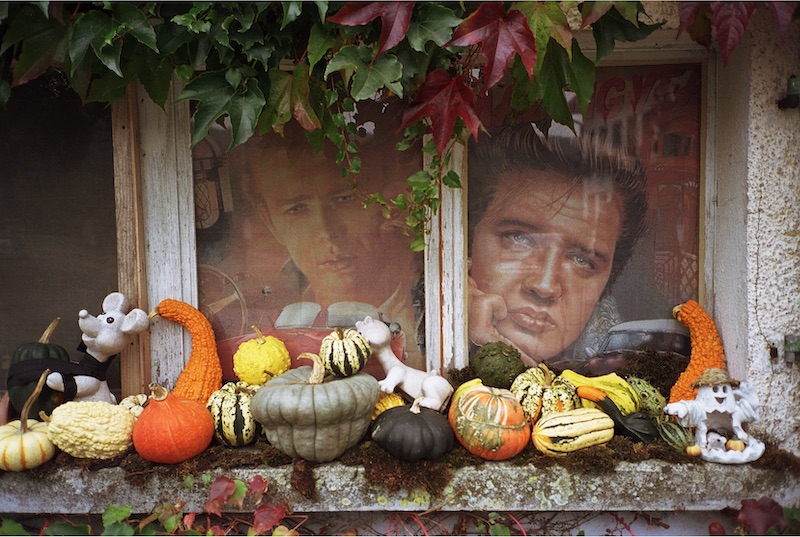
Download Press Release
Download Extended Checklist and Map
Swiss Institute is pleased to present the first institutional survey of celebrated Zürich-based artist Walter Pfeiffer in the United States. The exhibition, the artist’s most wide-ranging to date, primarily consists of artwork shown publicly for the first time. Pfeiffer is recognized as a key figure of contemporary photography, having ascended to prominence within Zürich’s countercultural circles in the 1970s. Infamous at the time for his frank depictions of gay sex juxtaposed with scenes of domestic solitude and snapshots of friends, Pfeiffer explores the syntax of pictures: how acts of arrangement and modes of presentation generate moods and associations. Organized chronologically, the exhibition brings together photographs, paintings, drawings, videos and collages made by Pfeiffer over the last six decades to showcase the artist’s approach to capturing life’s pleasures, poetics and oddities in images. From still lifes to landscapes to portraits, Pfeiffer’s style oscillates between graceful naturalism and playful self-awareness.
Pfeiffer was born in the rural village of Beggingen, Switzerland in 1946 and moved to Zürich in 1966 to attend the newly established experimental art school, Form & Farbe, as a member of its inaugural class. There he was first exposed to the satirical and disruptive attitudes of Dada, an artistic movement which was founded in the city fifty years prior, as well as to Pop Art. To support his newfound art practice, Pfeiffer worked as a graphic designer and stylist for Globus department store, illustrating advertisements and arranging window displays. A towering painting of a cat’s expectant face made in this period greets visitors to SI’s gallery.
Whilst living communally in a 19th century villa on Freigutstrasse in the center of the city, Pfeiffer began photographing friends, lovers and visitors to his home, using flash to correct a blur caused by his tremulous hands. He quickly began to incorporate photography into his artistic practice, expanding upon the stylings of Wilhelm von Gloeden, the portraiture of George Platt Lynes and Herbert List, the tableaux of Paul Outerbridge and Luigi Ghirri, as well as the aesthetics of beefcake magazine Physique Pictorial. Alongside detailed pencil drawings of body parts and mundane objects, these photographs demonstrate Pfeiffer’s blending of precise timing with the casual, often impish attitudes of his models.
In 1974, at the invitation of Swiss curator Jean-Christophe Ammann, Pfeiffer participated in the groundbreaking exhibition Transformer: Aspekte der Travestie at Kunstmuseum Luzern. Inspired by the fluidity of gender, sexual reflexivity and the stylings of Glam rock musicians, the exhibition placed Pfeiffer in dialogue with artists including Urs Luthi, Luciano Castelli and Katharina Sieverding. In addition to providing the catalogue’s cover, Pfeiffer presented 19 photographs of Carlo Joh, his muse, who died shortly before the exhibition’s opening. This survey marks the first time these prints have been exhibited since their original display.
Following a decade of travel and collaborations, Pfeiffer seldom left Zürich in the 1990s, retreating from the the circuits of contemporary art to focus on painting and teaching. The resultant solitary nature of Pfeiffer’s practice prompted a shift towards scenes free of bodies: kaleidoscopic still lifes, flower paintings and nature photography that, in spite of their personless content, still simmer with a vitality also present in Pfeiffer’s depictions of homes and interiors. Views of Pfeiffer’s current apartment complex undergoing renovation, cast against an overcast sky, are accompanied by a portrait of the artist’s mother and a drying rack strewn with white garments. In parallel with these quotidian studies, Pfeiffer’s attraction to opulence emerges. In a more recent photograph, the windows of Marie Antoinette’s bedroom in the Petit Trianon are shown ajar, overlooking the Temple of Love.
Distinguished by their tonal variety, a selection of Pfeiffer’s self-portraits are installed on SI’s second floor gallery alongside a display of the artist’s scrapbooks, an integral element of his practice developed from 1971 to the early 1990s. In agendas, binders and notebooks, Pfeiffer formulates collages as punchlines, integrating his own photographs amongst 3-D objects and images cut from fashion magazines and classified ads. Reminiscent of the absurdist potency and irreverent spirit found in collages made by Hannah Höch and later William S. Burroughs and Brion Gysin, Pfeiffer’s books meticulously synthesize color, form, texture and language into a droll vernacular unique to the artist. On the opposite wall, three monitors cycle through hundreds of pages of Pfeiffer’s unpublished journals and the guestbook of his Freigutstrasse villa, while a fourth plays two videos: Music for Millions (1977) and The Plaza (1985-2001). In the former, Pfeiffer and friends experiment with a camera in his studio, tuning the radio to different stations, dressing and dancing in accordance with the changes in frequency. Across these varied formats and stages, Pfeiffer conveys in pictures how life’s vacancies are punctuated by eruptions of expression and charm. With both distance and intimacy, the artist illustrates these spontaneous revolutions.
SI gratefully acknowledges the support of Bottega Veneta as Main Partner of Walter Pfeiffer. Additional support is generously provided by Art + Commerce. SI wishes to thank the lenders to the exhibition: Beda Achermann; Verena & H.R. Fricker; Torvioll Jashari; Fotomuseum Winterthur; Bob van Orsouw; Ernst Reich; Galerie Gregor Staiger, Zurich; Galerie Sultana, Paris. SI also thanks Philippe Brutus, Remo Eyer, Patrick Frey, Michel Gilgen and Andrea Kempter. Walter Pfeiffer wishes to thank Edy Marconi for his production support.
On the occasion of the exhibition, a new monograph on Pfeiffer featuring commissioned texts by Devrim Bayar, Dean Kissick, Wayne Koestenbaum, Meredith North and José B. Segebre Salazar, will be published with Lenz Press in late Summer 2022.
This exhibition is organized by Simon Castets, former SI Director, and Daniel Merritt, Curator and Head of Residencies.
Walter Pfeiffer (b. 1946, Beggingen CH) is a Zurich-based artist. He has had solo exhibitions at Kunsthaus Zurich (1982); Kunsthalle Basel (1986); Centre Culturel Suisse, Paris (2004); Fotomuseum Winterthur (2009); Grand Palais, Bern (2012). Group exhibitions include Zurcher Kunstler, Kunsthaus Zurich (1973); Transformer: Askpete der Travestie, Kunstmuseum Luzern (1974); Swiss Video, Tate Modern, London (2006); Another Kind of Life: Photography on the Margins, Barbican Gallery, London (2018); amongst many others. He has produced several publications, including Welcome Aboard – Photographs 1980 – 2000 and most recently Bildrausch. Drawings 1966-2018, both published by Edition Patrick Frey.

Image: Walter Pfeiffer, Untitled, 2003. Courtesy of the artist.
Video by Ieva Lygnugaryte.
Press

Untitled, 1966-1967. Mixed media on fiberboard. 105 x 107 in. Collection of Ernst Reich.
In 1966, Walter Pfeiffer moved to Zürich to attend art classes at Form + Fabre, a newly established art school led by educator and Marcel Duchamp scholar Serge Stauffer and
artist Hansjörg Mattmüller. At this time, Pfeiffer was immersed in discourses of 20th century art: theories of color and shape established by the Bauhaus, philosophies of the absurd linked to Dada, and satirization of commercialism circulated by Pop Art in the 1960s. Liberated to create art that reflected his own interests and curiosities, Pfeiffer produced this large-scale depiction of a kitten across three panels of a folding screen. Upon its completion, Pfeiffer donated the work to an elementary school in the small town of Neunkirch, near his hometown, where it sat on display in a stairwell for decades.
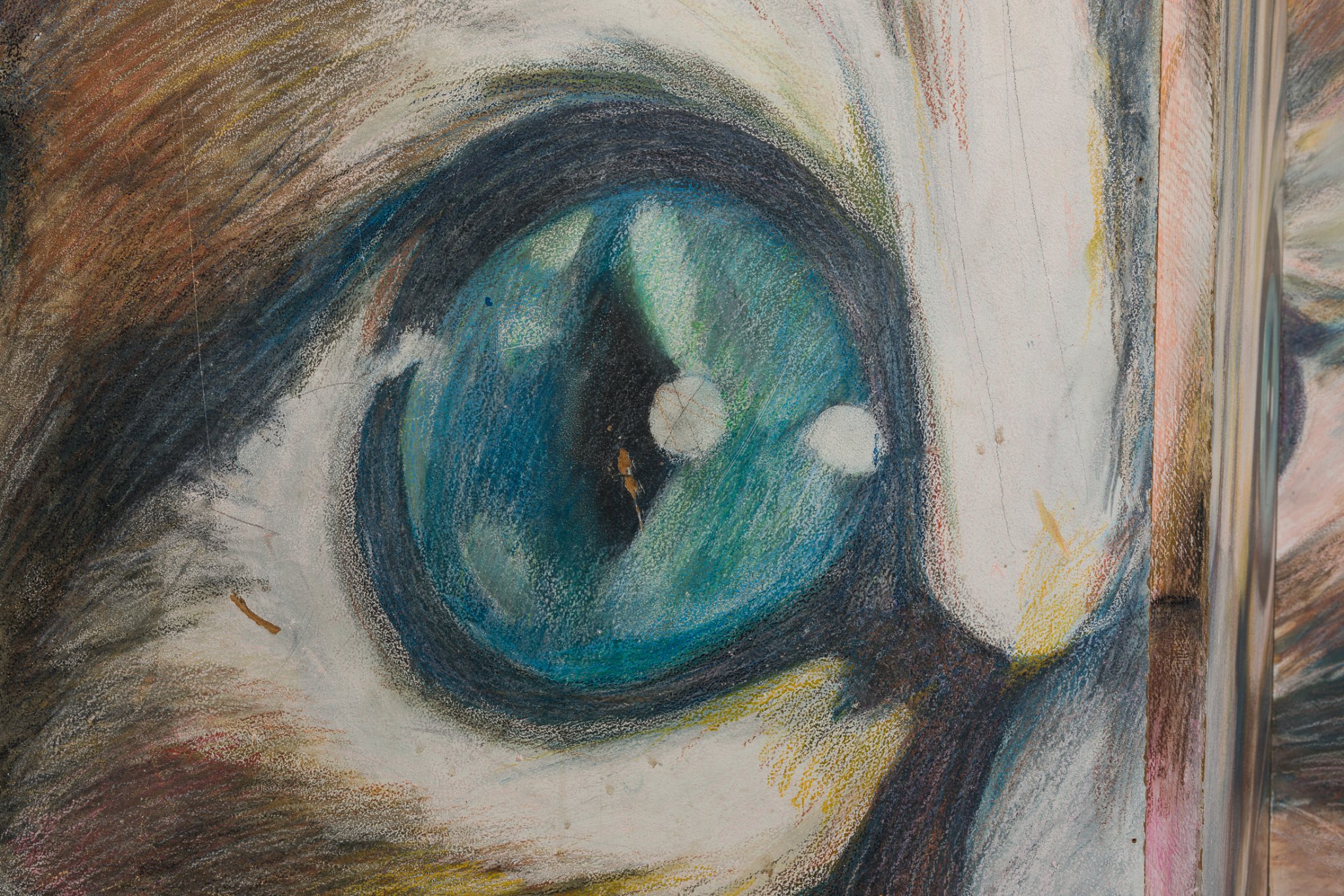
Untitled, 1966-1967, detail.
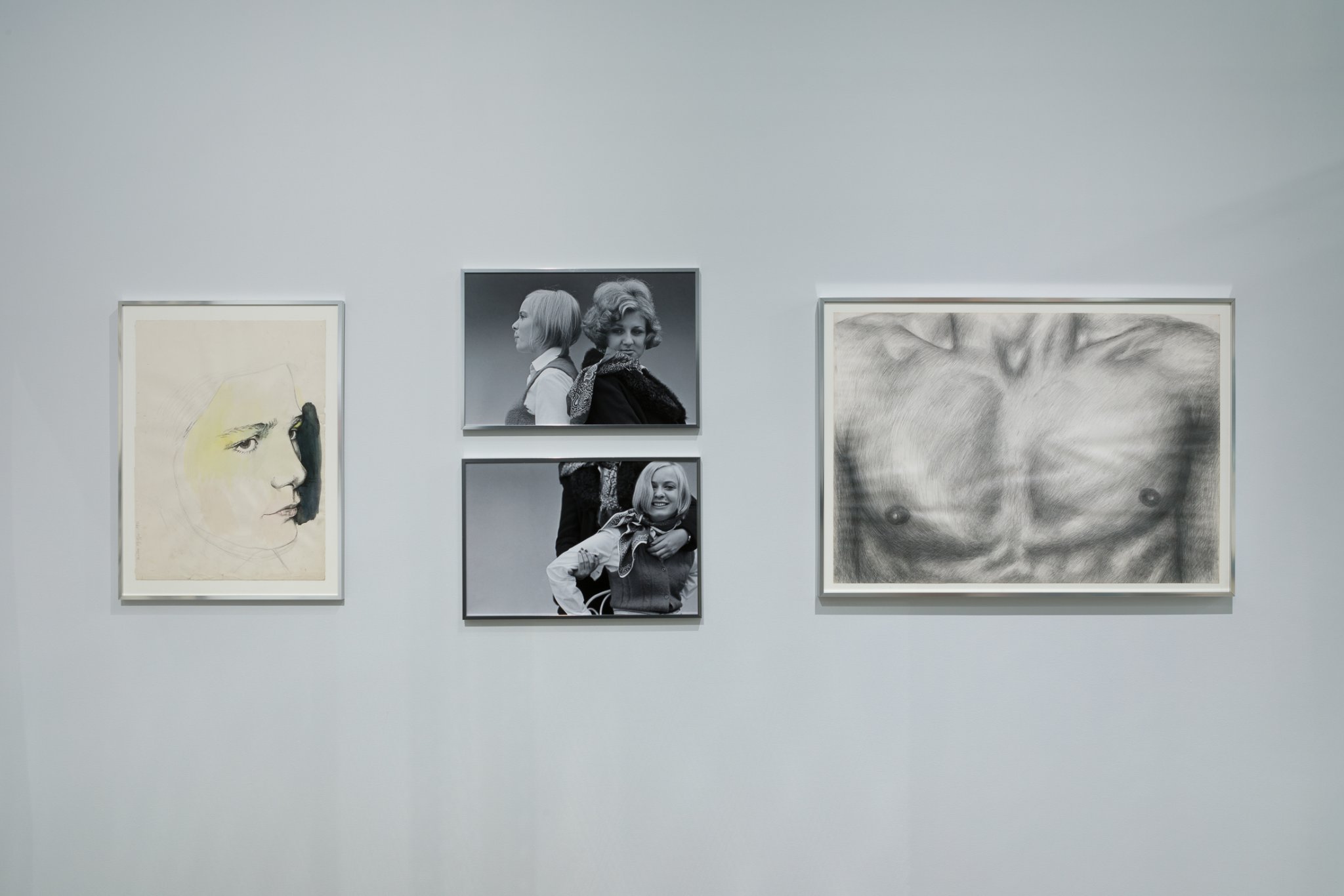
Walter Pfeiffer, installation view.
Pfeiffer identifies these central portraits of his sister, Maja, and friend, Lisa Enderli, as his first photographs. While his signature style of flash photography would develop throughout the 1970s, these early experiments with a camera showcase Pfeiffer’s interest in posing and dress.
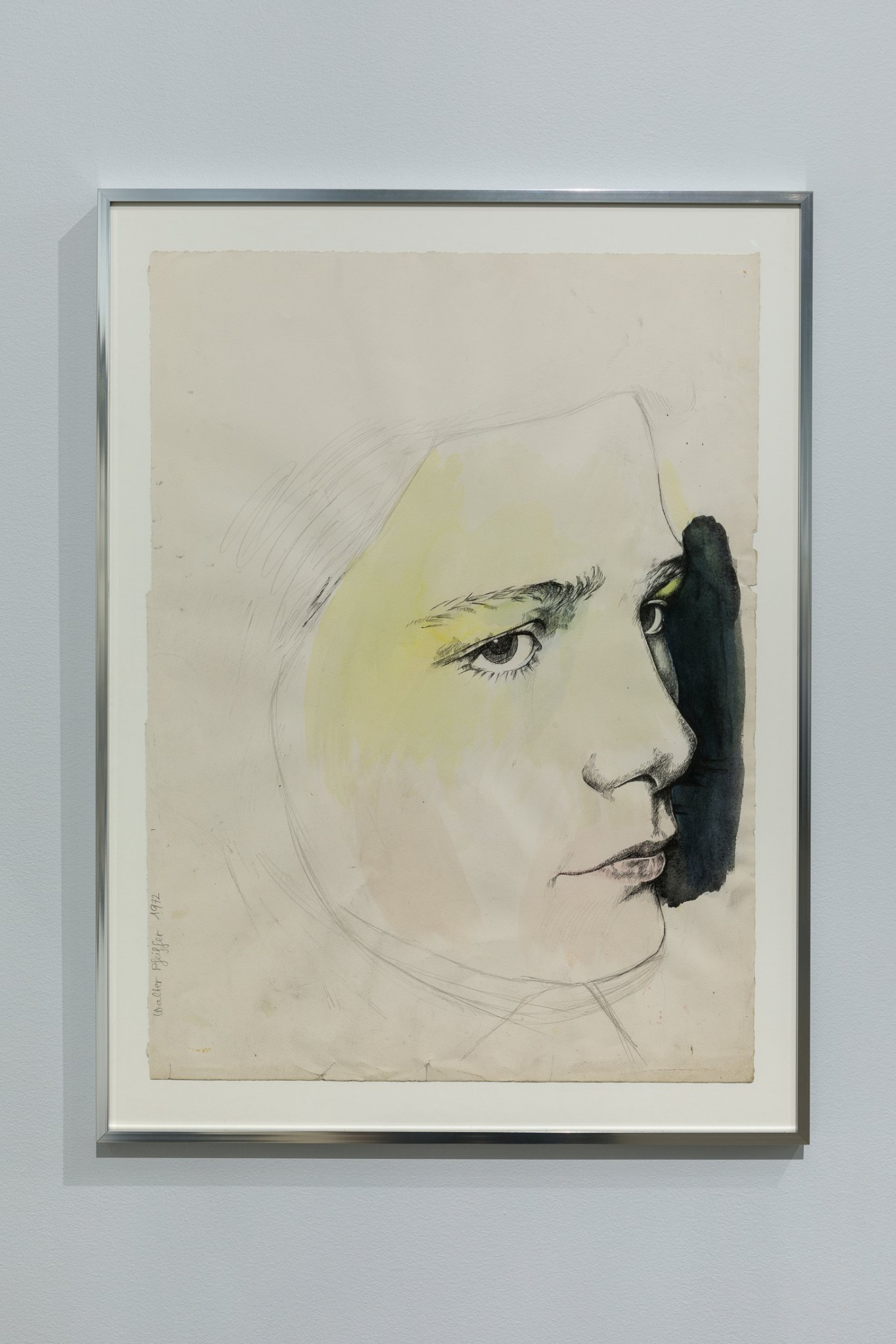
Untitled, 1972. Watercolor and pen on paper. 19 x 26 in. Courtesy of the artist.
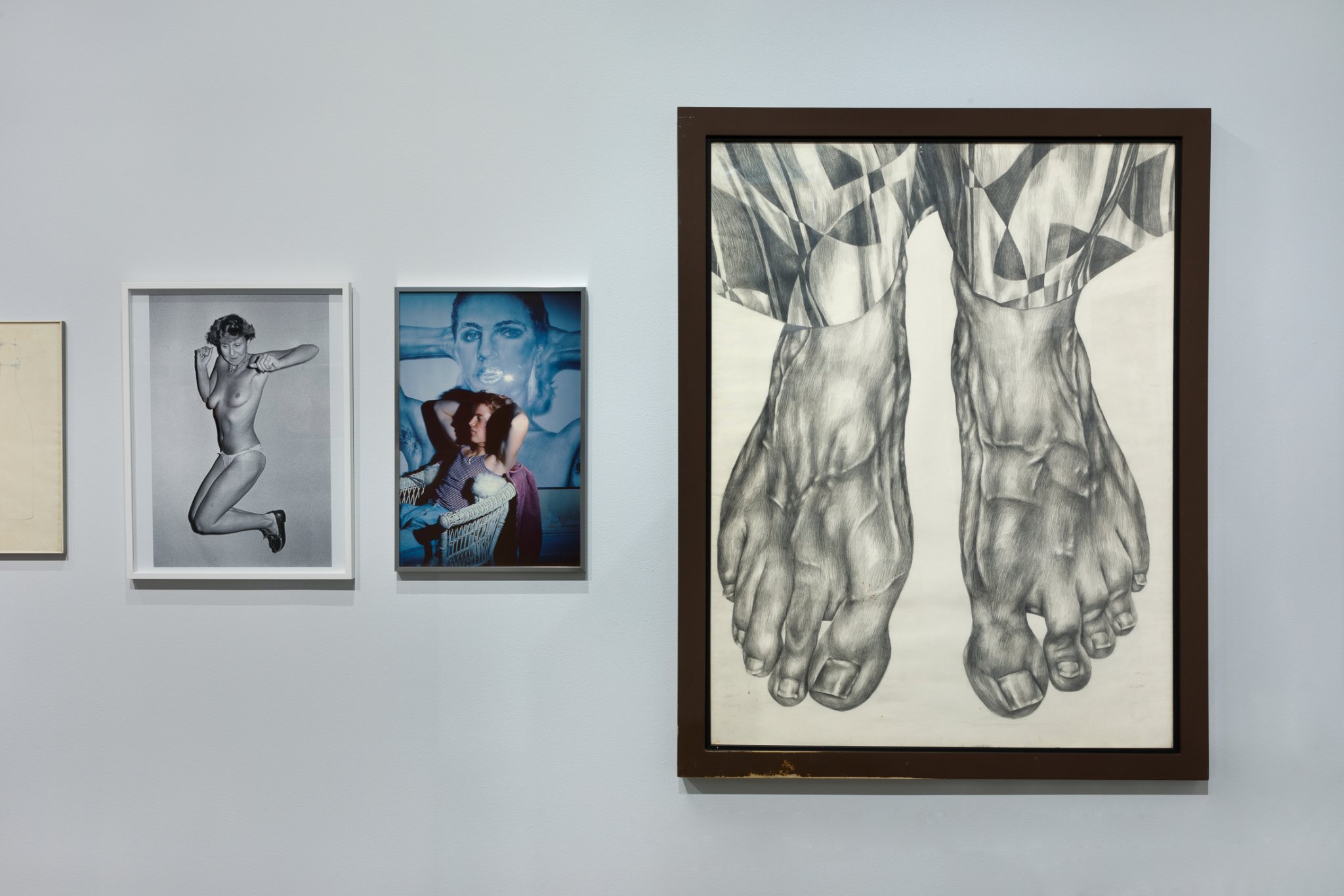
Walter Pfeiffer, installation view.
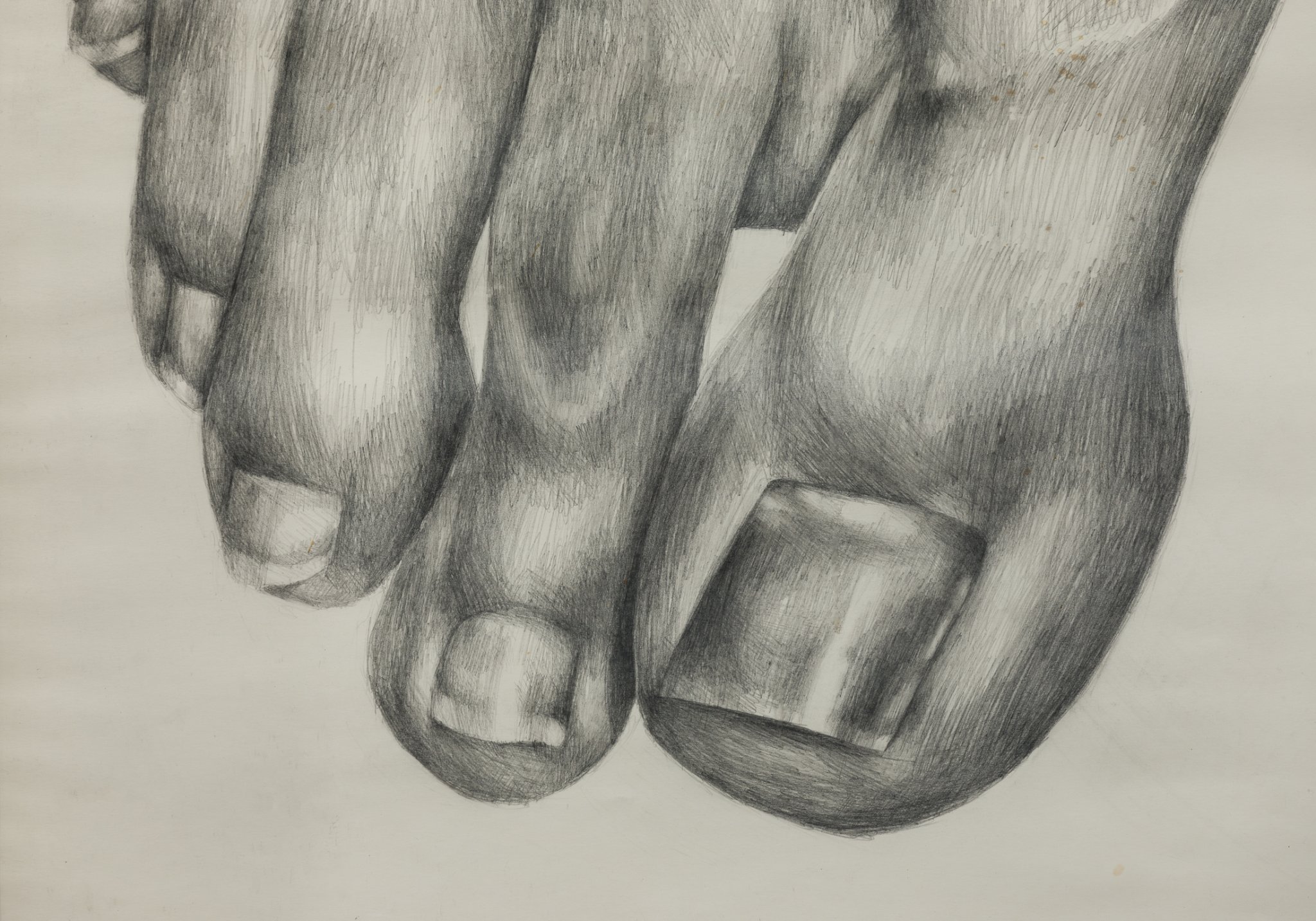
Untitled, 1972, detail. Pencil on paper. 51 x 39 1/3 in. Courtesy of the artist and Galerie Gregor Staiger, Zürich.
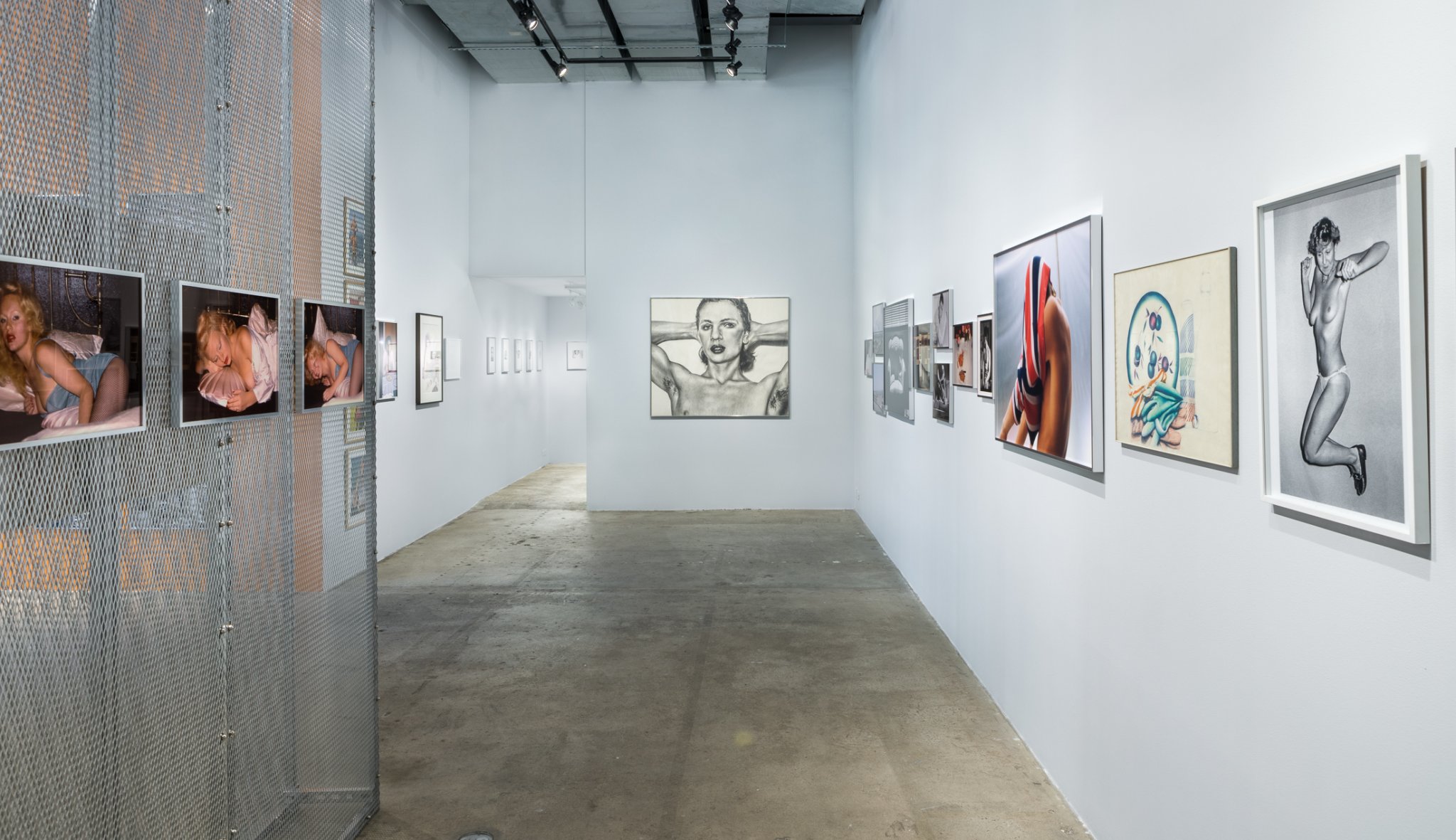
Walter Pfeiffer, installation view.
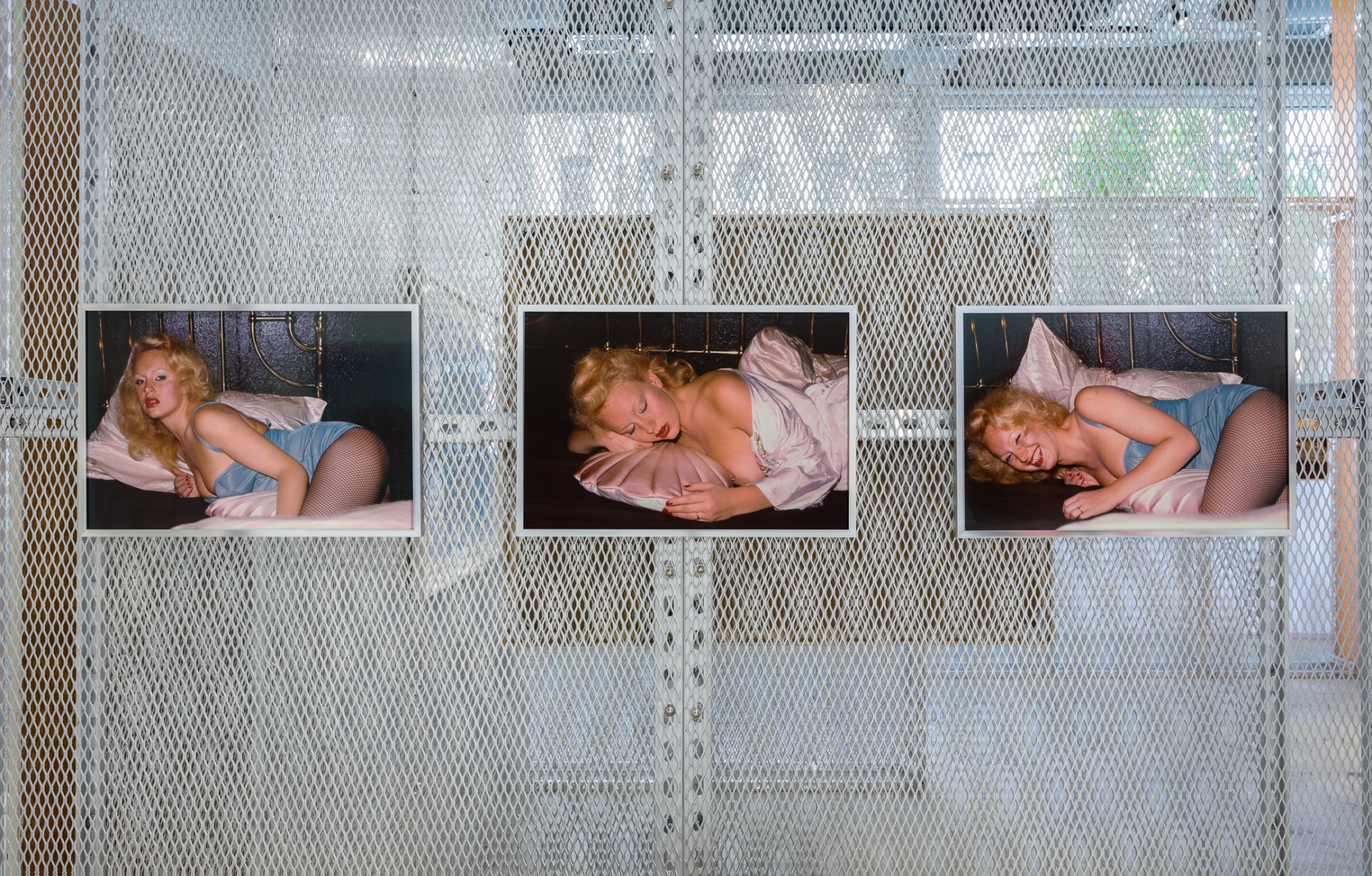
All works:
Untitled, 1975 (2022). Pigment ink prints. 12 x 17 ¾ in.
Three photographs depict German actress and sex worker Irene Staub posing on satin sheets while gazing provocatively at Pfeiffer’s camera. These pictures served as source material for Pfeiffer’s illustrated film posters for the Zürich cinema Filmpodium, whose commissions supported Pfeiffer financially in the early 1970s. Later in the decade, Staub became a muse for artists including Luciano Castelli, Roswitha Hecke and Franz Gertsch, who depicted her in a monumental photorealist portrait in 1980.
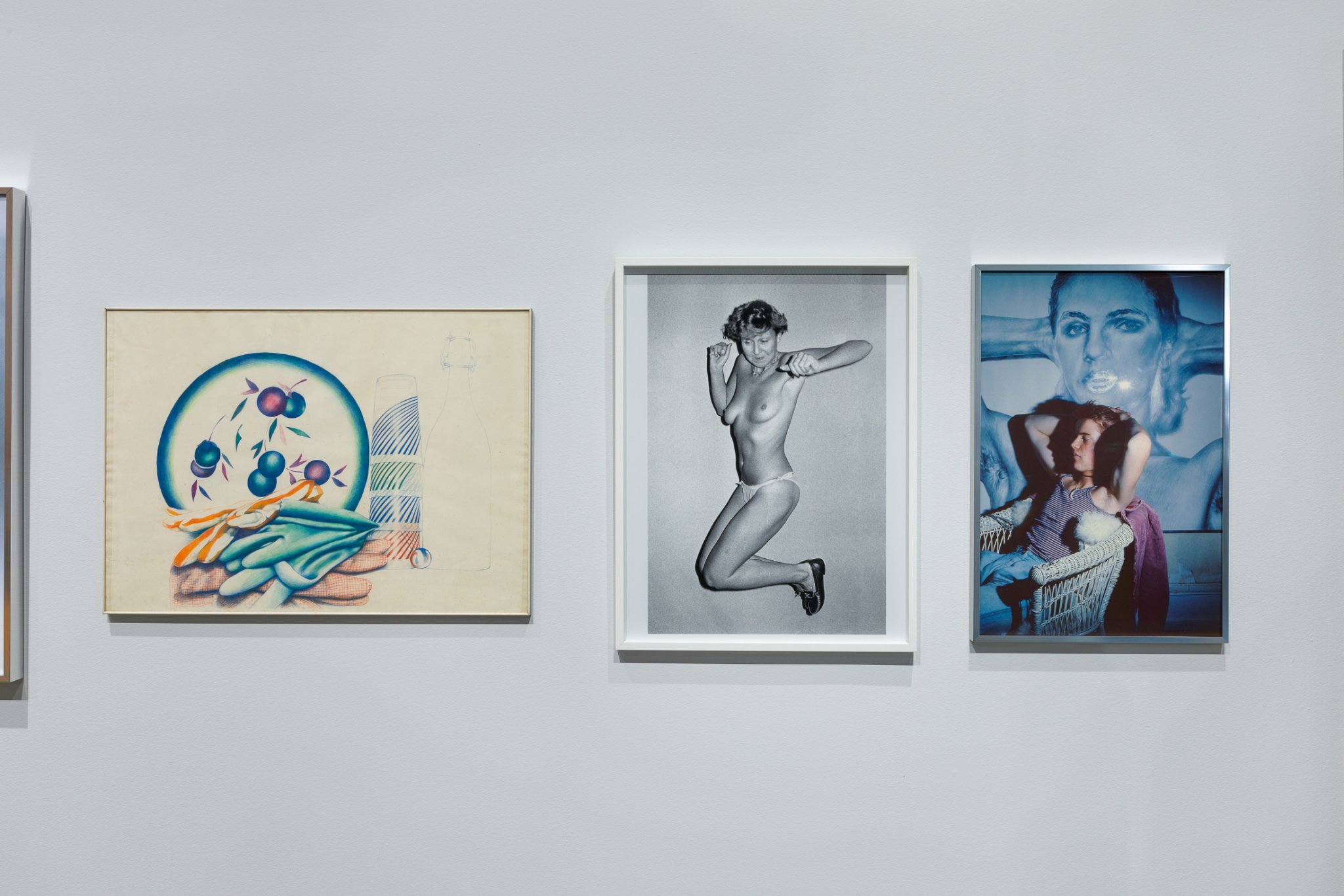
Walter Pfeiffer, installation view.
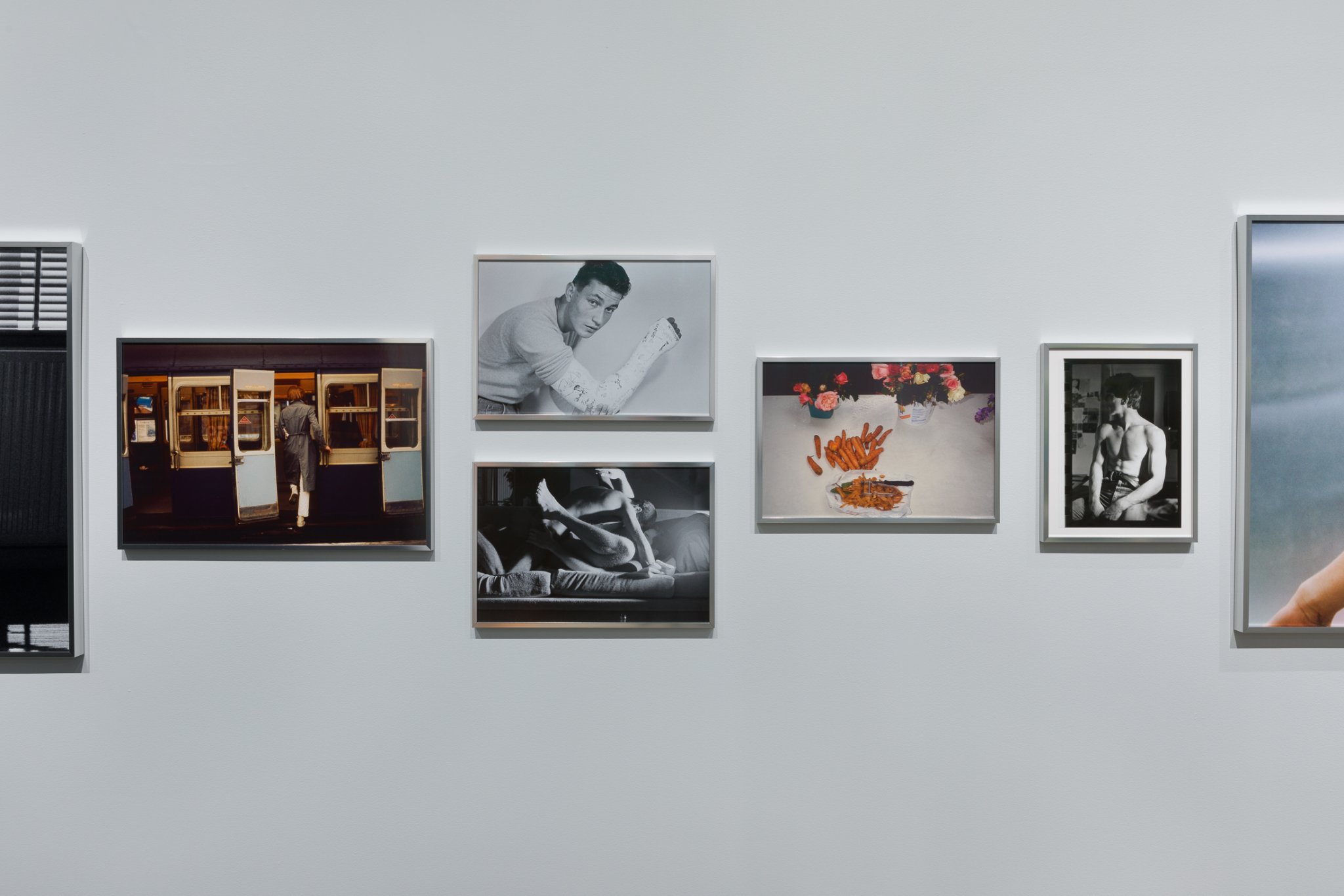
Walter Pfeiffer, installation view.
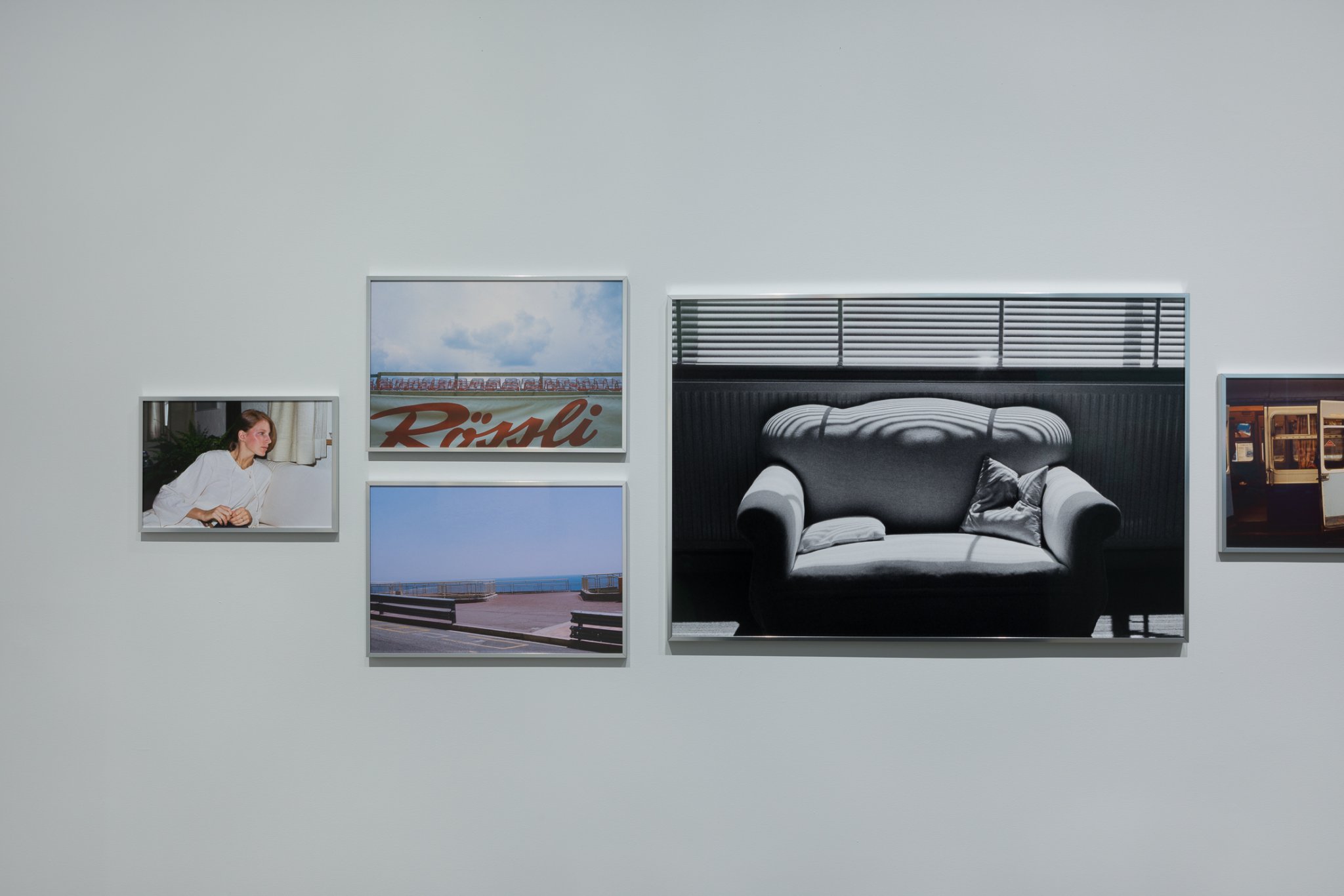
Walter Pfeiffer, installation view.
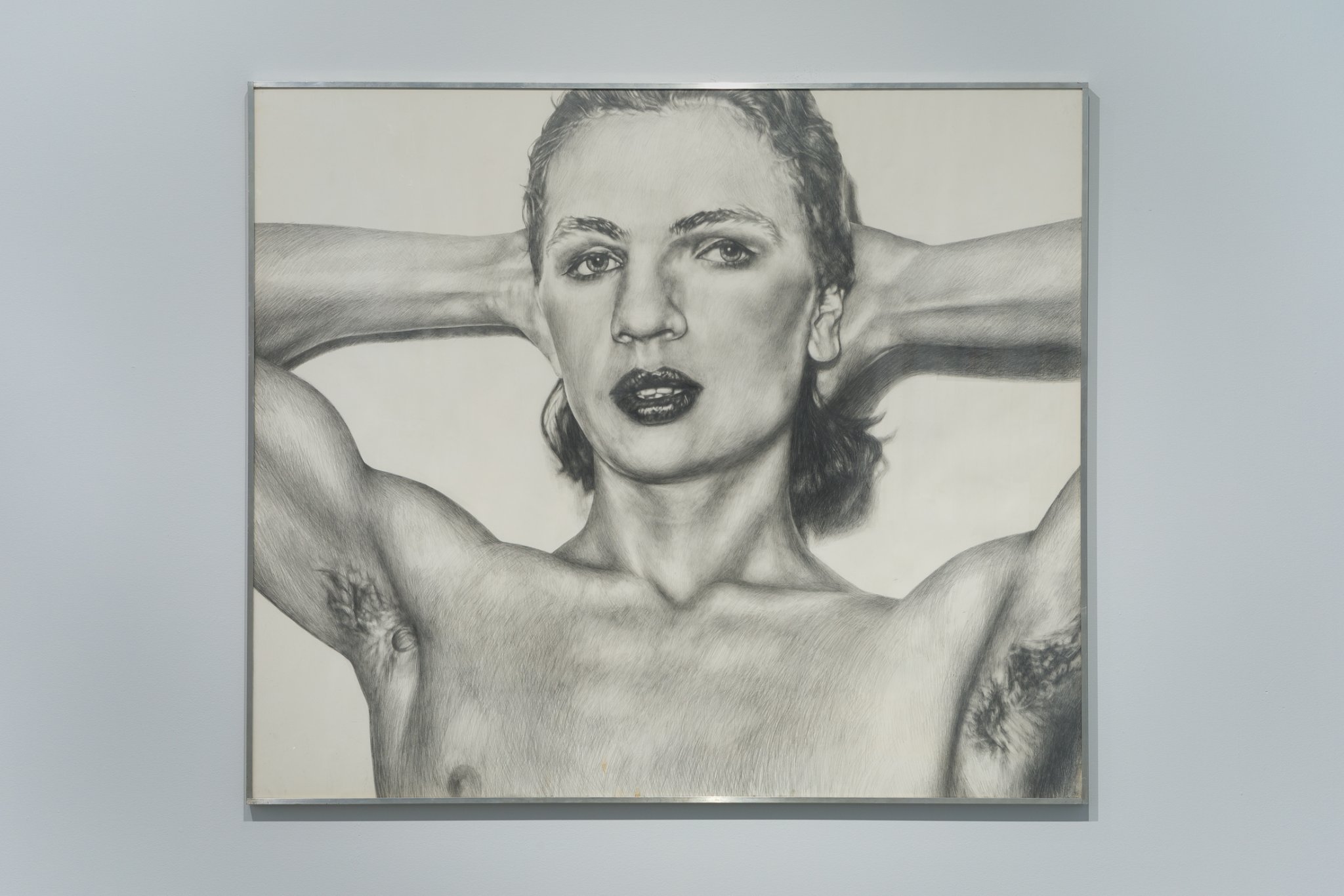
Carlo Joh, 1973. Pencil on paper. 66 x 39 1/3 in. Courtesy of the artist and Galerie Gregor Staiger, Zürich.
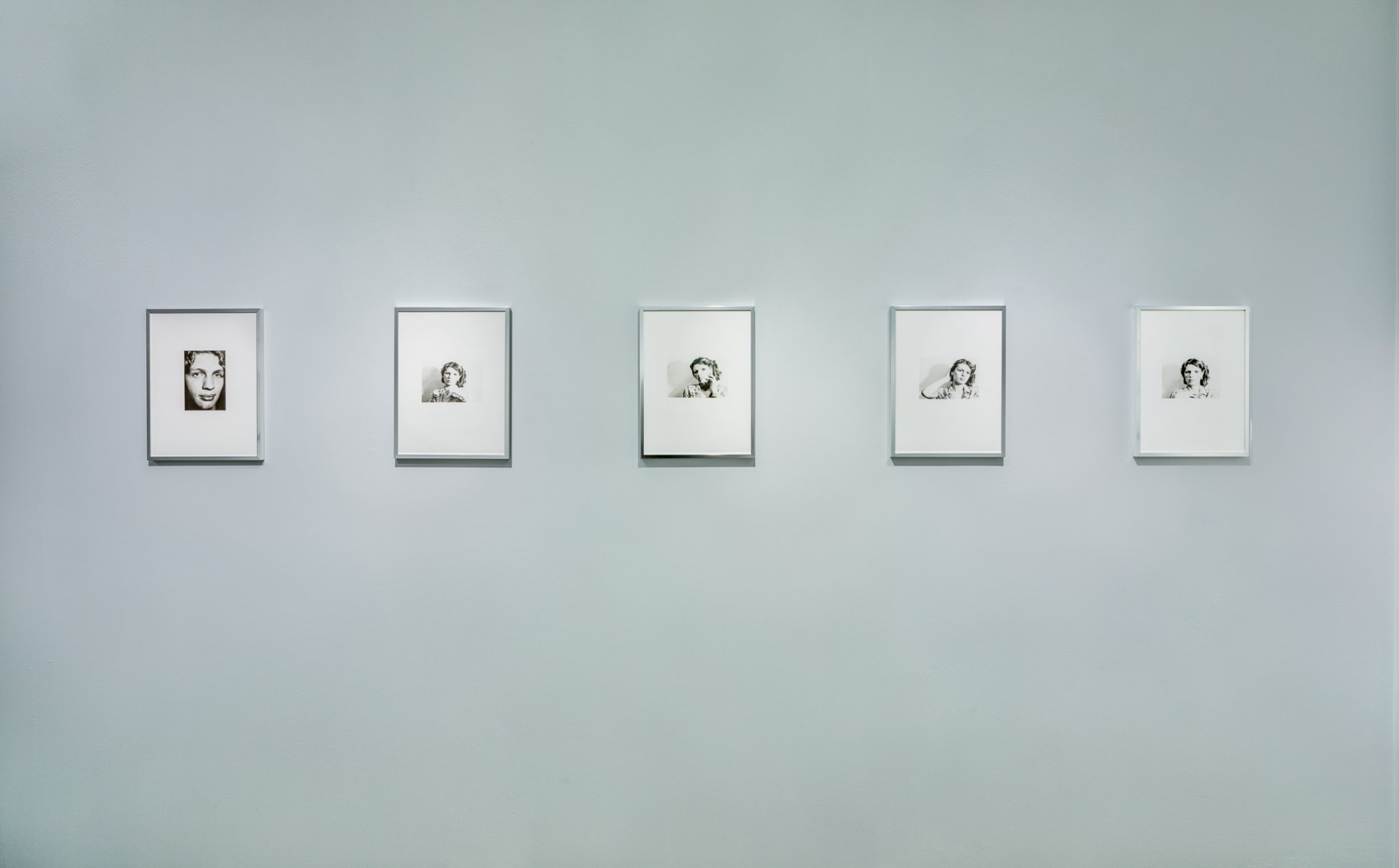
All works:
Untitled, 1973. Gelatin-sliver print on document paper. 8 ¼ x 11 ¾ in. Courtesy of the artist and Galerie Gregor Staiger, Zürich.
In 1973, Pfeiffer was invited by Swiss curator Jean-Christophe Ammann to participate in a group exhibition at Switzerland’s Kunstmuseum Lucerne entitled
Transformer: Aspekte der Travestie. Groundbreaking for its perceptive
understanding of gender fluidity and sexual expression in both contemporary art circles and popular music at the time, the exhibition placed artists like Pfeiffer and Urs Luthi in dialogue with Brian Eno, Mick Jagger and the New York Dolls. For his contribution, Pfeiffer enlisted a new muse named Carlo Joh, whom he had met in the library of Zürich’s art school earlier that year. Across four sittings, Pfeiffer photographed Joh in varying states of dress and drag, light and shadow. The 19 photographs shown here were printed surreptitiously in the art school’s photo lab on special document paper, lending them a subtle metallic sheen. Shortly after the exhibition in Lucerne closed, Joh died of an undisclosed illness. Pfeiffer’s exhibition at Swiss Institute marks the first time these works have been presented since their original 1974 showing in Lucerne.
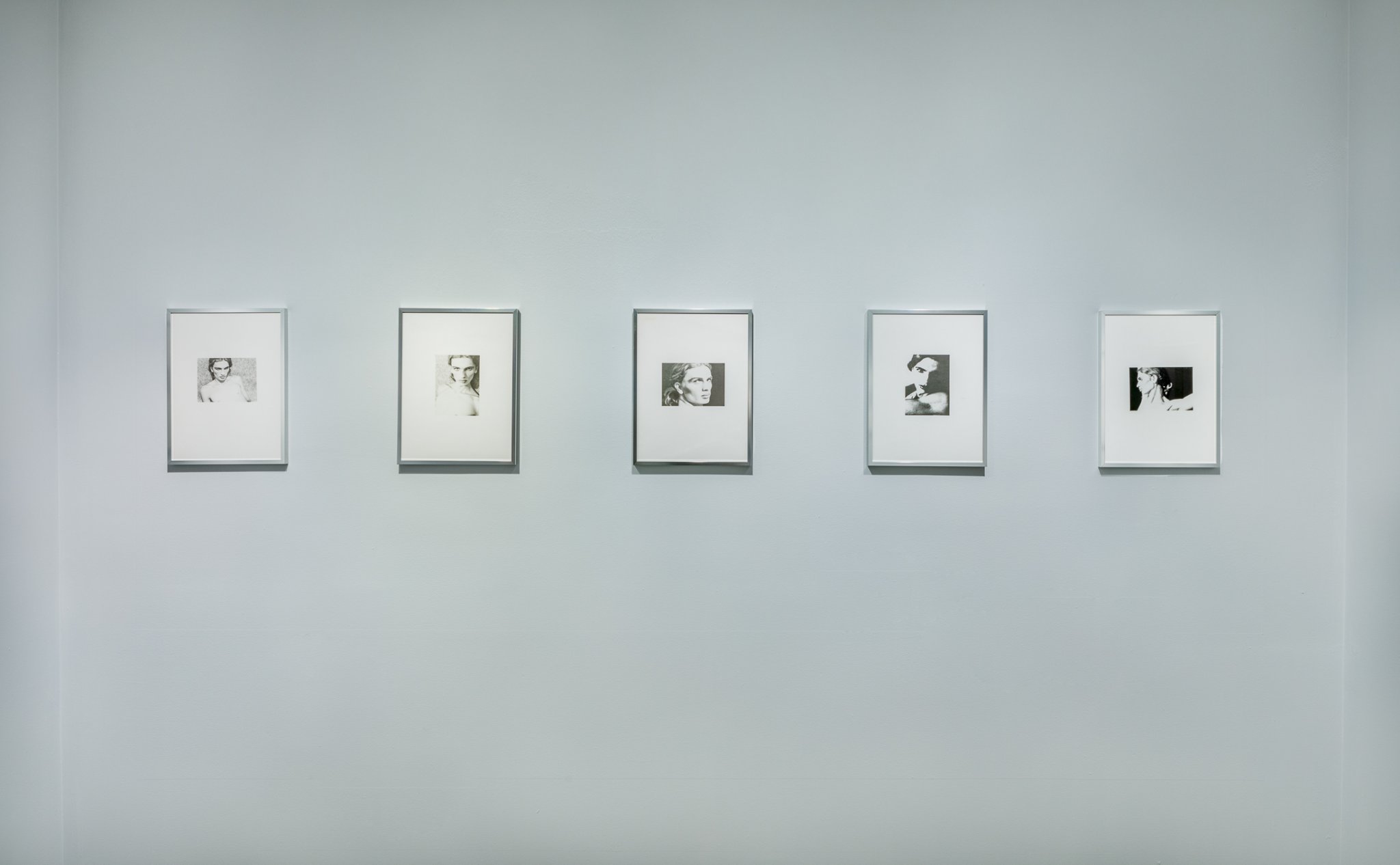
All works: Untitled, 1973.
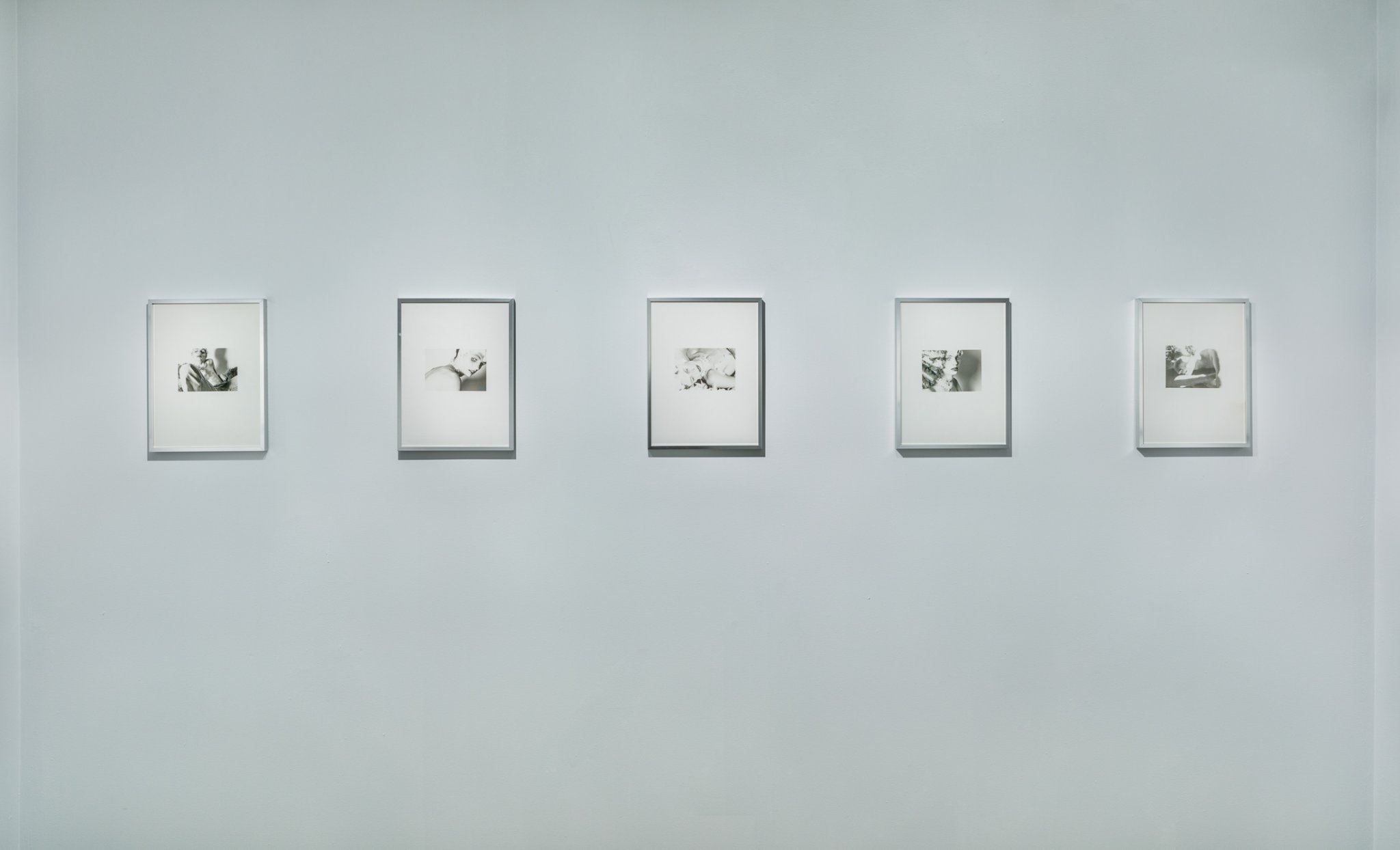
All works: Untitled, 1973.
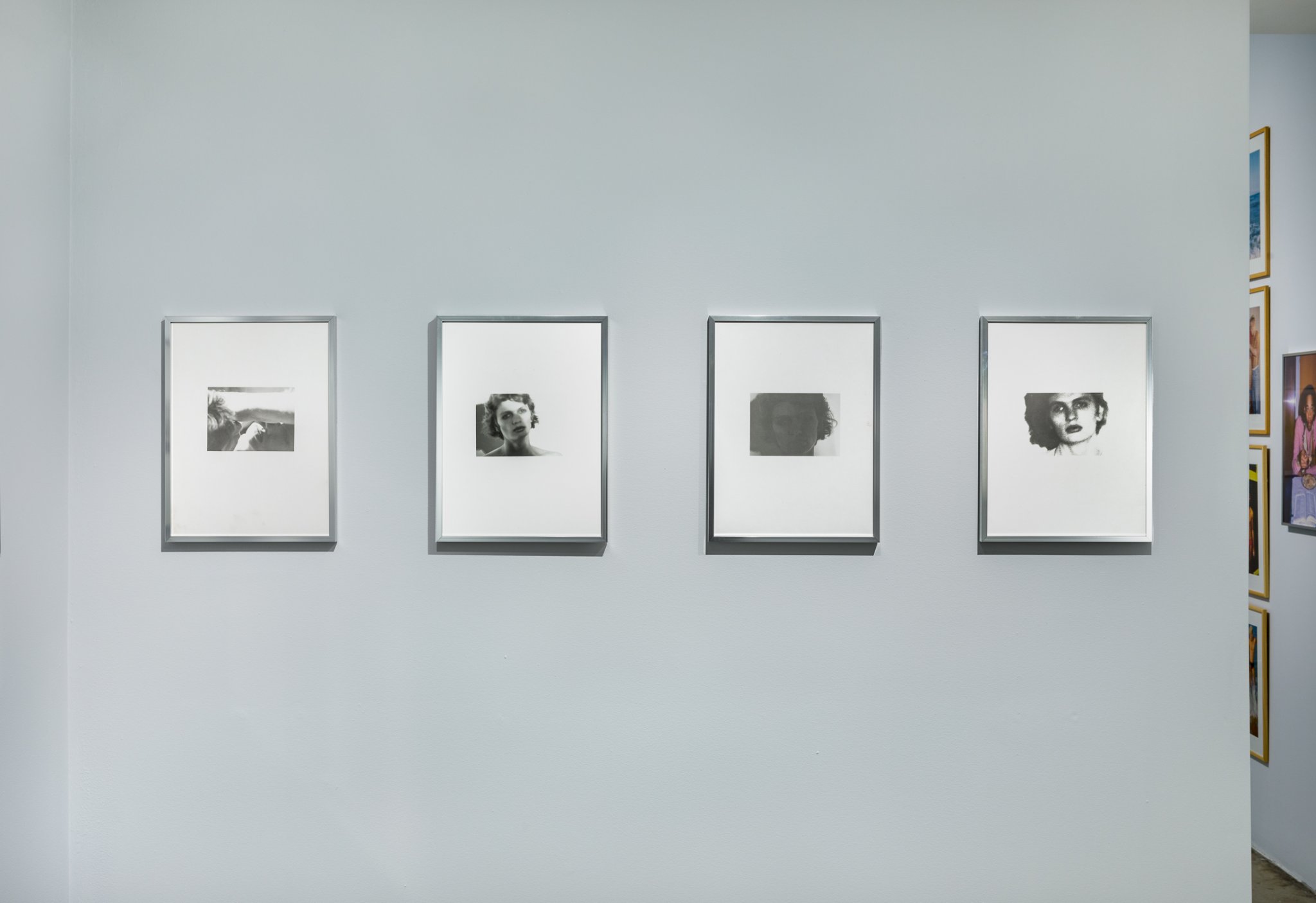
All works: Untitled, 1973.
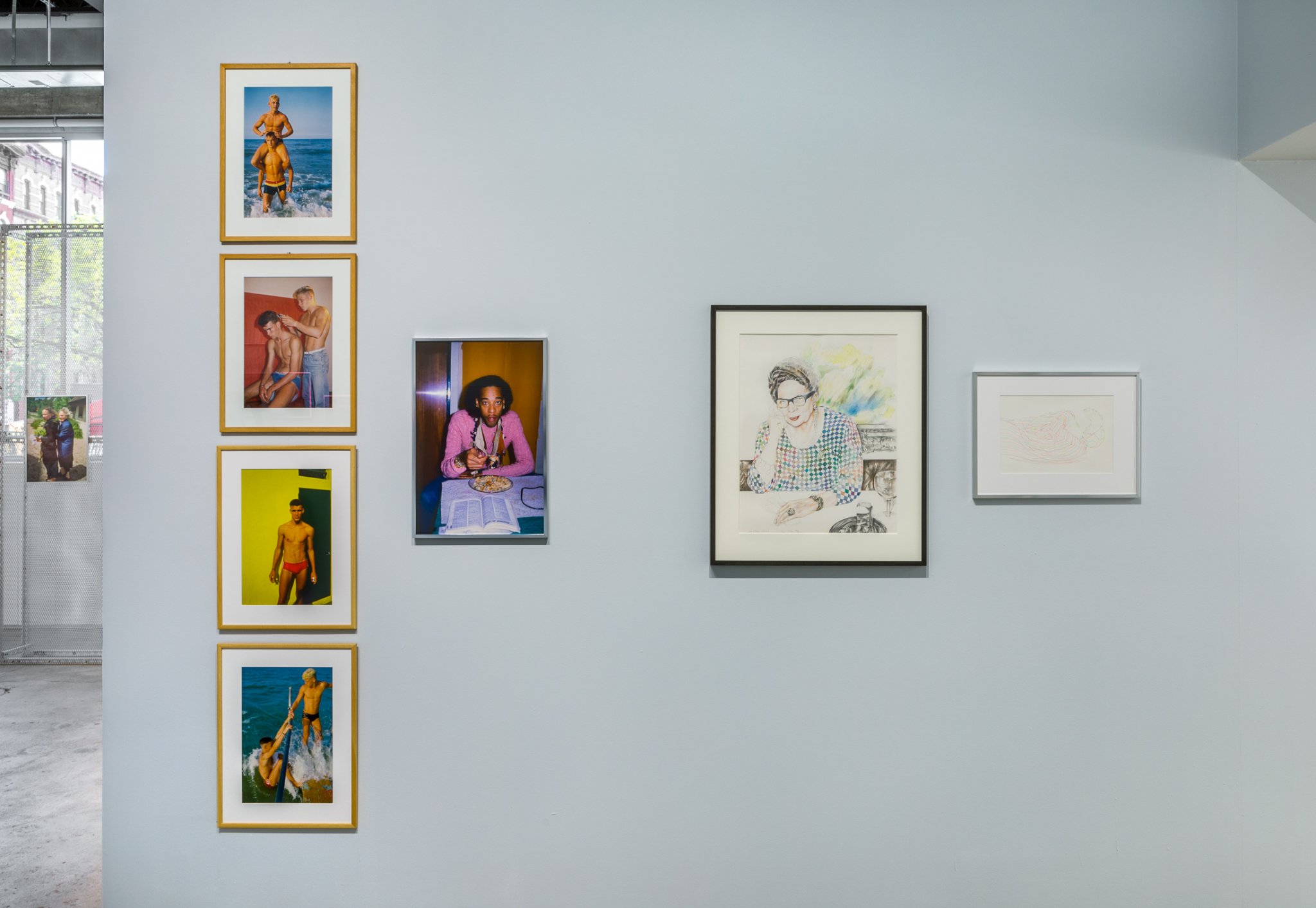
Walter Pfeiffer, installation view.
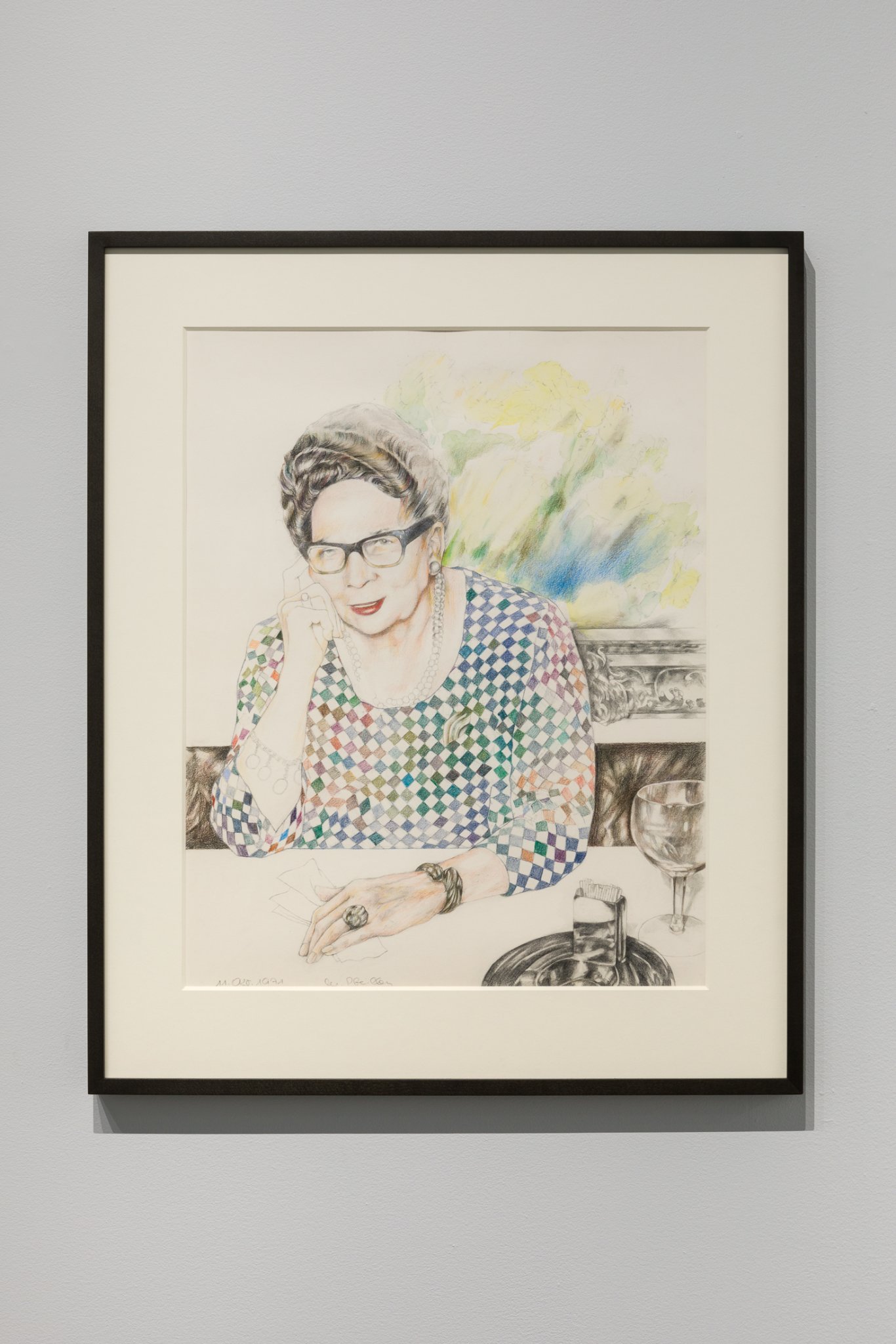
Untitled, 1971. Colored pencil on paper. 31 ¼ x 26 in. Courtesy of Restaurant Kronenhalle, Zürich.
This early pencil drawing depicts Hulda Zumsteg (1890-1984), Swiss hostess, restauranteur and proprietor of the Kronenhalle, Zürich’s renowned dining room and bar. Both a muse and a patron, Zumsteg counted Bertold Brecht, Christobal Balenciaga and Yves Saint Laurent amongst her customers and friends. Art from 20th century masters including Joan Miró, Pablo Picasso and Robert Rauschenberg adorns the walls of the entire establishment. A gift to her son, Gustav, Pfeiffer’s portrait of Zumsteg hangs in the
restaurant’s office.
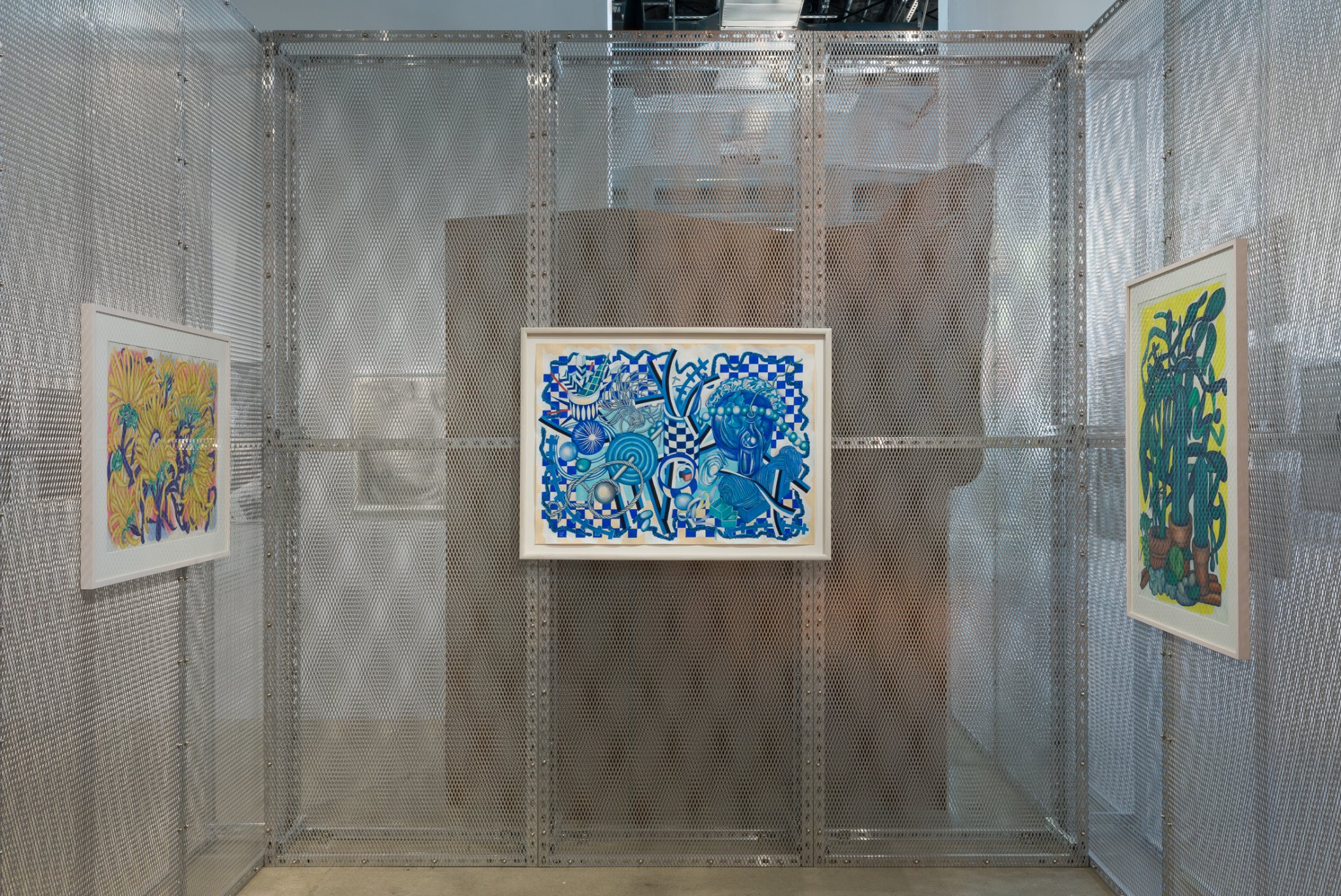
Walter Pfeiffer, installation view.
Following a decade of travel and activity in the 1980s, in which the artist produced a third photography book, exhibited at Kunsthalle Basel in a two-person exhibition with Bruce Weber (also curated by Ammann) and began photographing for erotic gay magazines such as
Gai Pied and
Torso, Pfeiffer’s interest shifted. In a more solitary practice of still life painting, he frequently depicts meticulously arranged, chromatically cohesive tablescapes and bouquets from his mother’s garden. Pfeiffer often takes photos of his arrangements as a preparatory measure before
painting, and later imbues his tableaux with psychedelic detail.
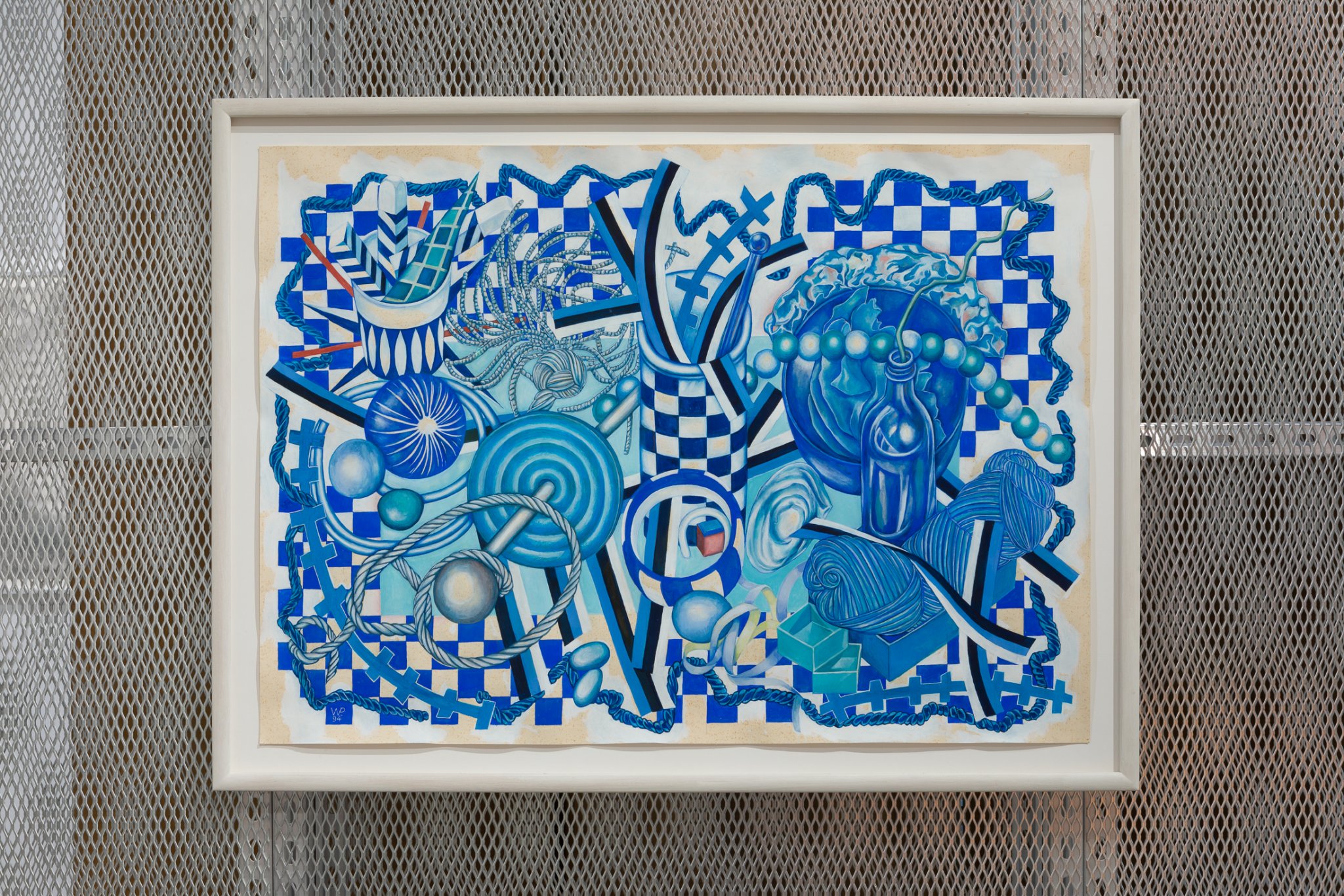
Untitled, 1994. Gouache on paper. 33 x 44 ¼ in. Collection of Torvioll Jashari.
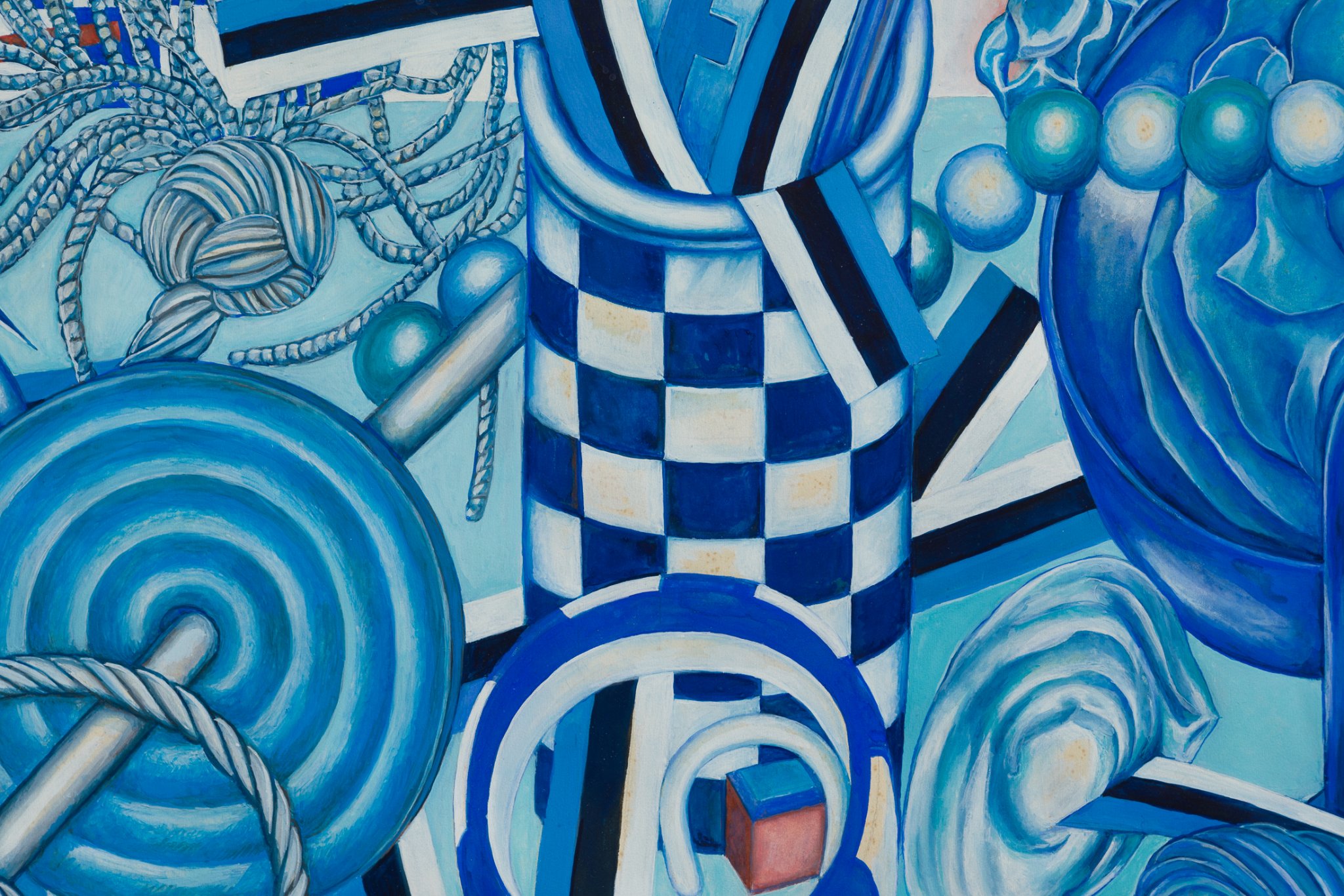
Untitled, 1994, detail.
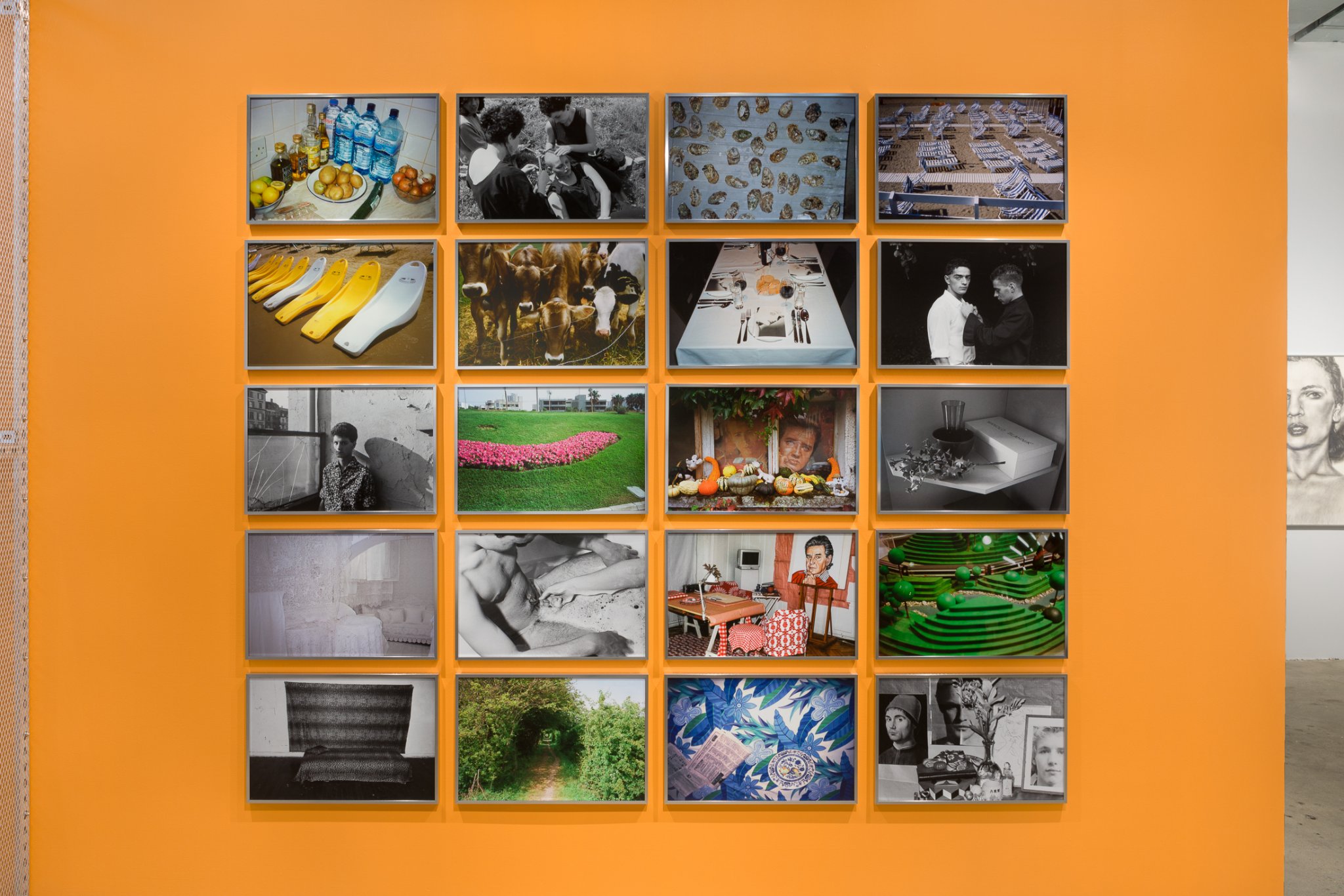
Walter Pfeiffer, installation view.
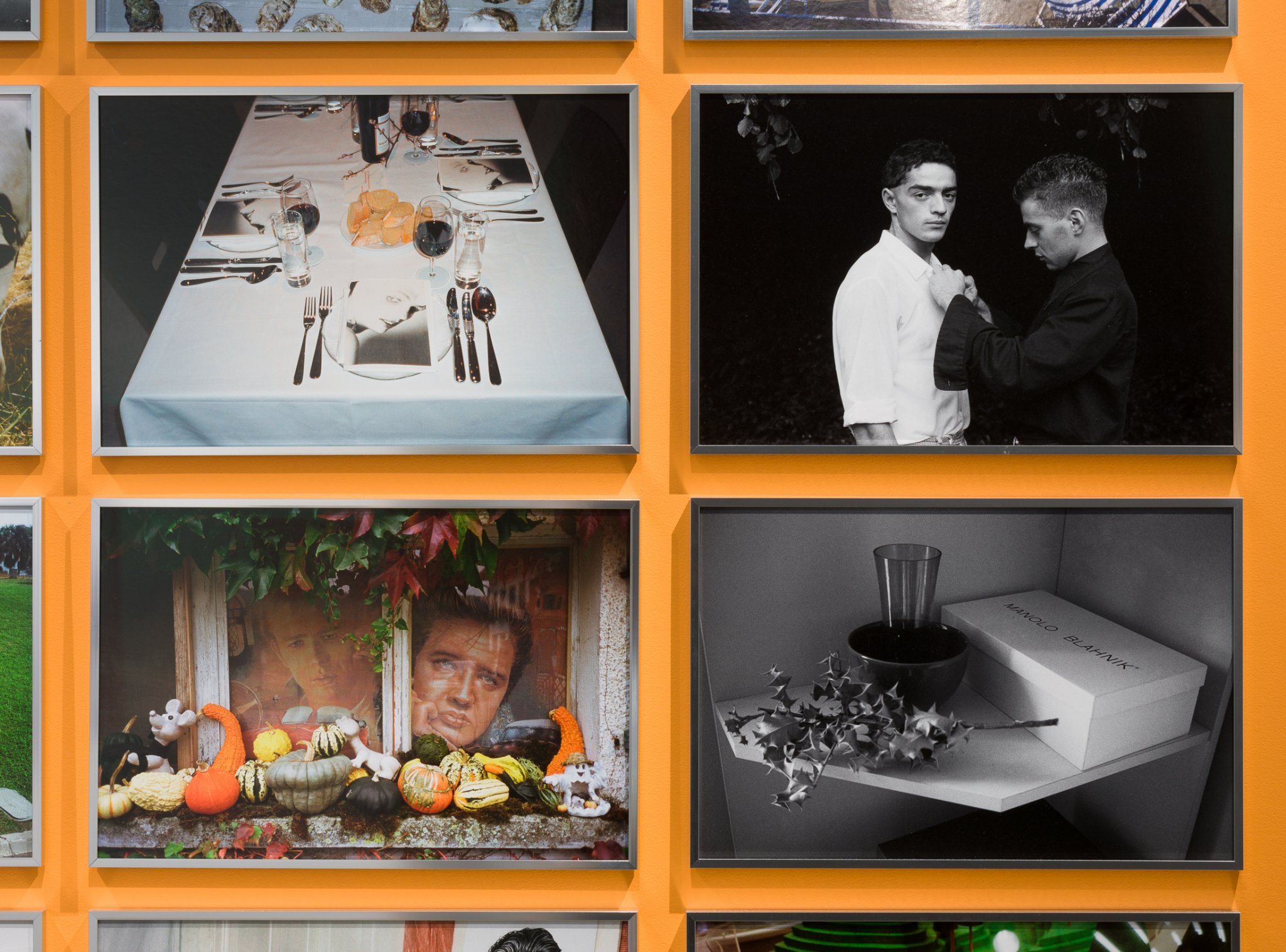
Walter Pfeiffer, installation detail.
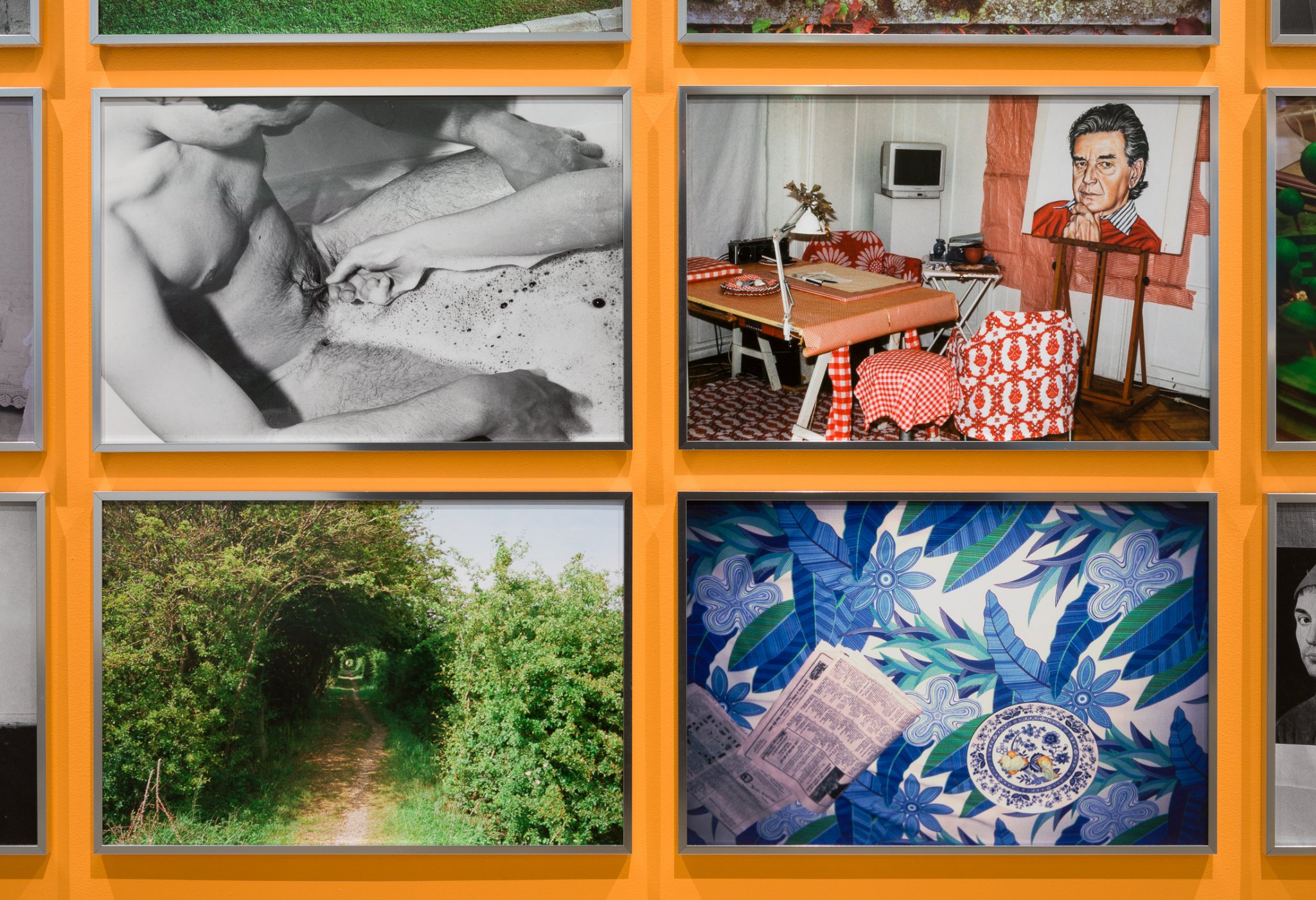
Walter Pfeiffer, installation detail.
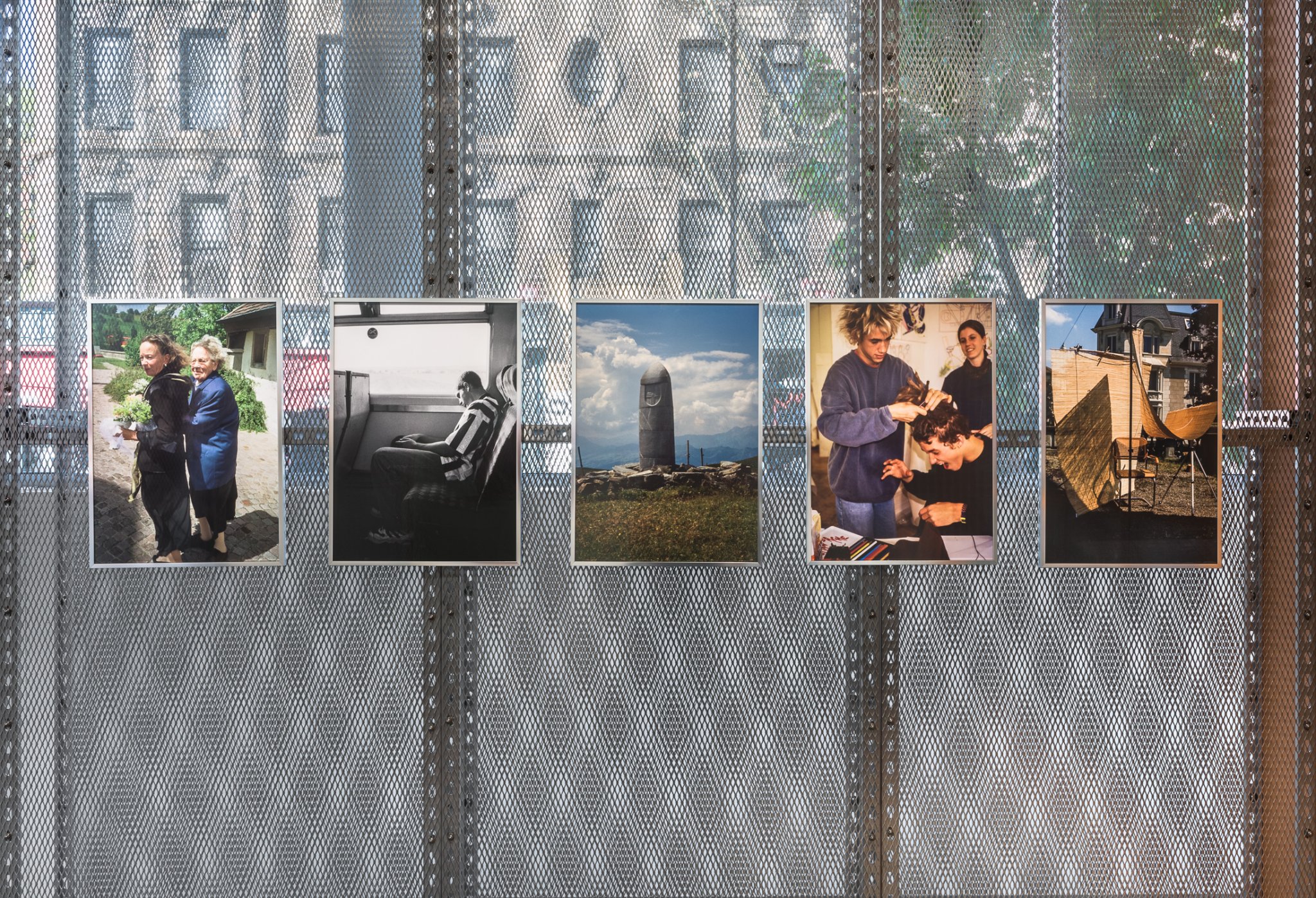
Walter Pfeiffer, installation view.
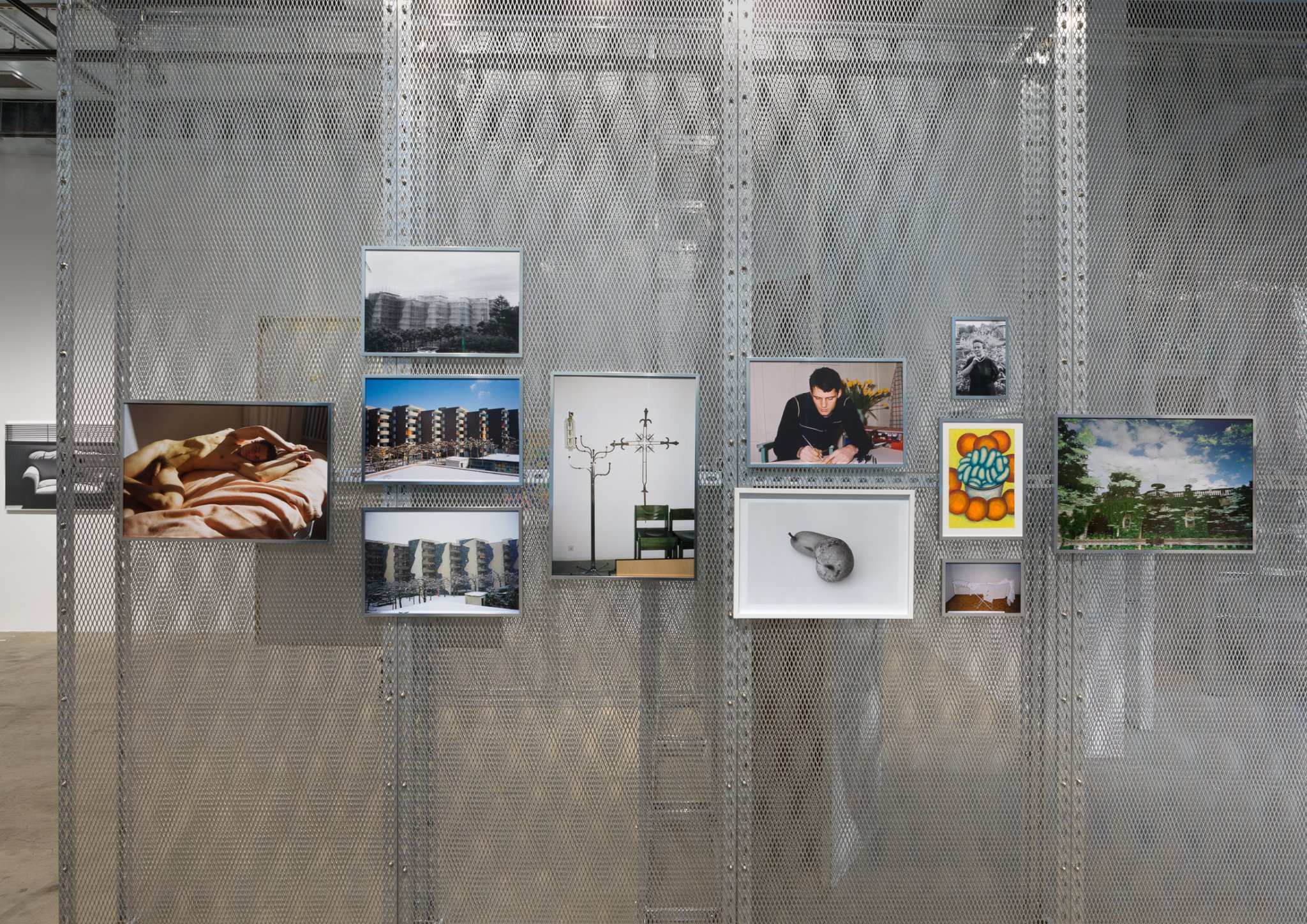
Walter Pfeiffer, installation view.
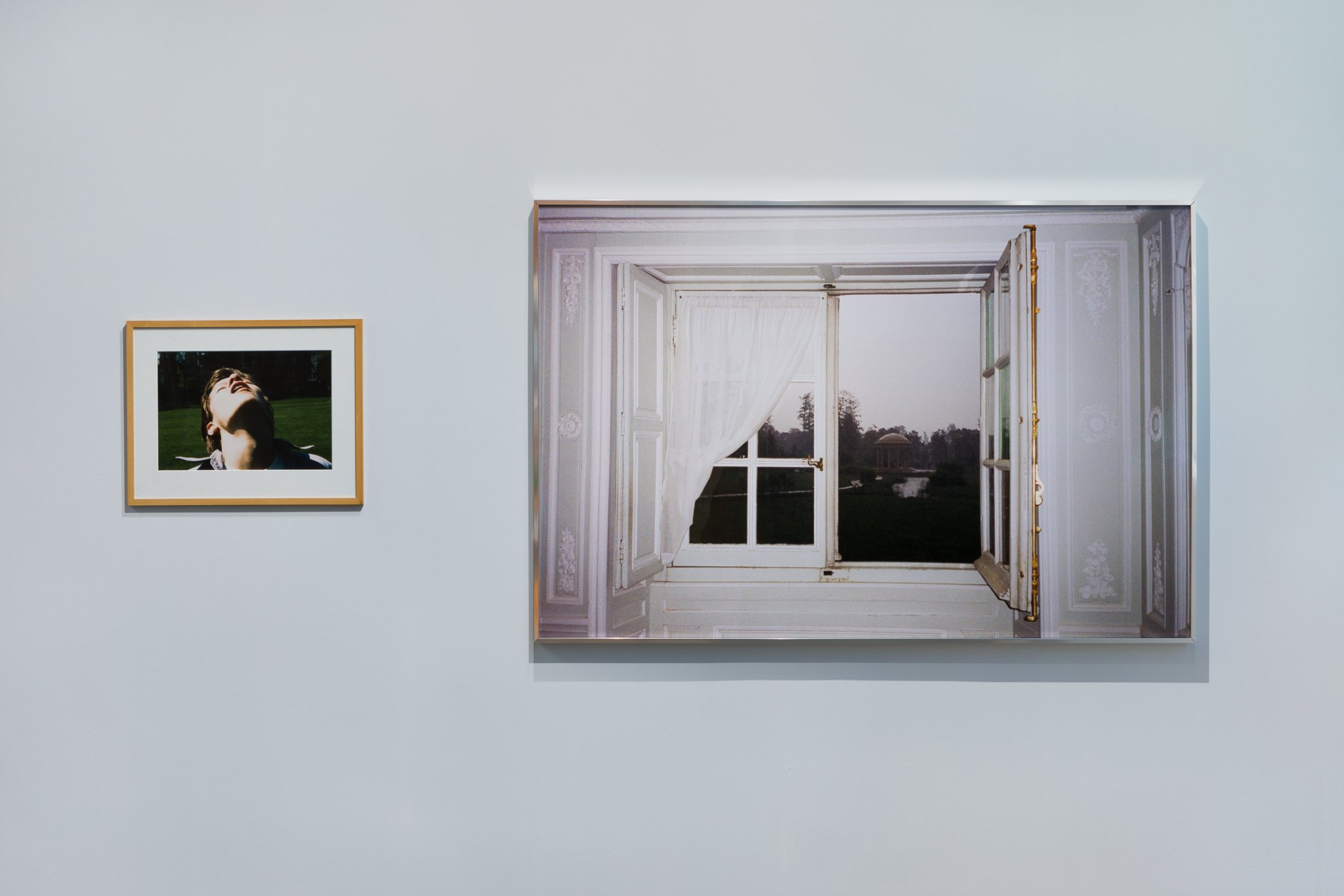
From left:
Untitled, 1975 (1992). Cibachrome print. 21 5/8 x 16 ½ in. Courtesy of the artist and Galerie Bob van Orsouw, Zürich
Untitled, 2016 (2022). Pigment ink print. 39 ½ x 59 ¼ in. Courtesy of the artist.
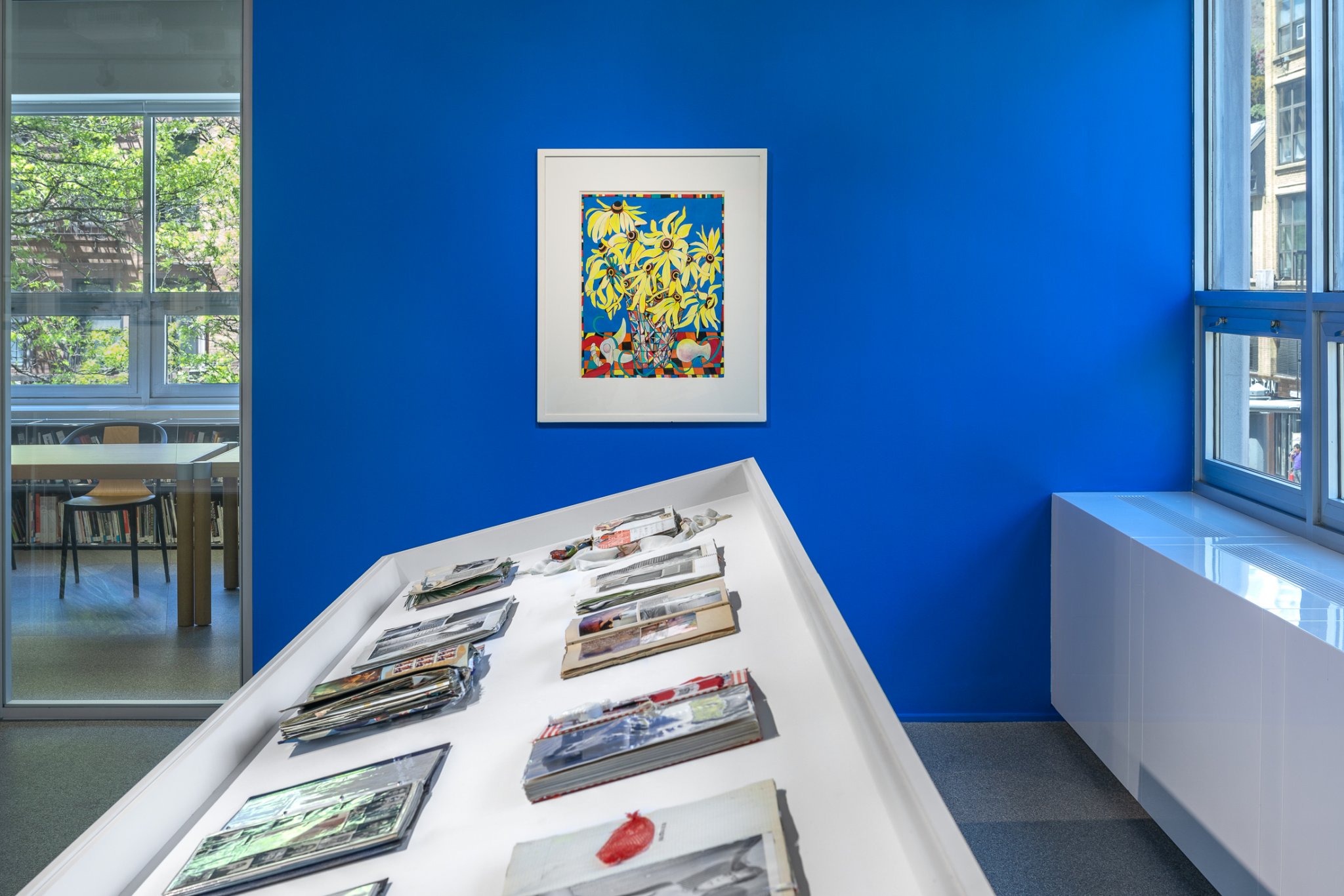
On wall: Untitled, 1990. Gouache on paper, 37 ½ x 31 ½ in. Collection of Torvioll Jashari.
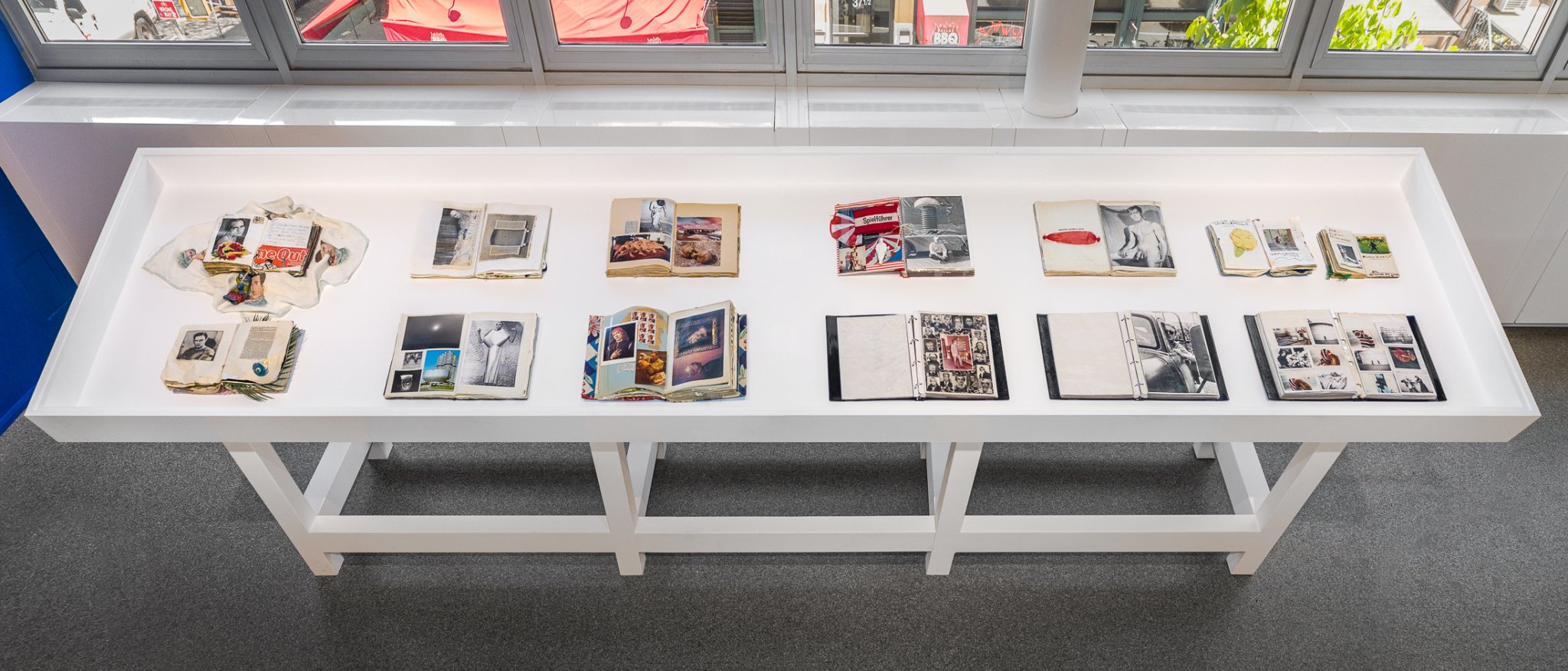
Selected Scrapbooks, 1971-1988.
Throughout his adult life, Pfeiffer has kept a series of notebooks, guestbooks and scrapbooks as both a diaristic endeavor and a forum for artistic experimentation. Pfeiffer’s notebooks are characterized by their extensive use of text, usually ruminations on a single prompt or concept. A photo, either the artist’s own or a clipping from a book, magazine or newspaper, typically accompanies the entry. Guestbooks,
which the artist made in the 1970s, follow a similar logic in which a single portrait is adorned with the subject’s signature and often a note to the artist. The scrapbooks (seen here,) the most formally diverse of the artist’s books, unite Pfeiffer’s photographs and clippings from print media with tchotchkes, souvenirs and occasionally foodstuffs. Pfeiffer started this
practice in 1971 when he began working for Zürich’s Globus department store and received a daily planner as a new employee. Rather than fill its pages with tasks, Pfeiffer used each page to accumulate images and items of interest
including: tabloid clippings, celebrity glamour shots, a baby’s pacifier, museum postcards and sausage casings. These subtly harmonious compositions, suffuse with deadpan and tawdry humor, typify Pfeiffer’s interest in arrangement and affect.
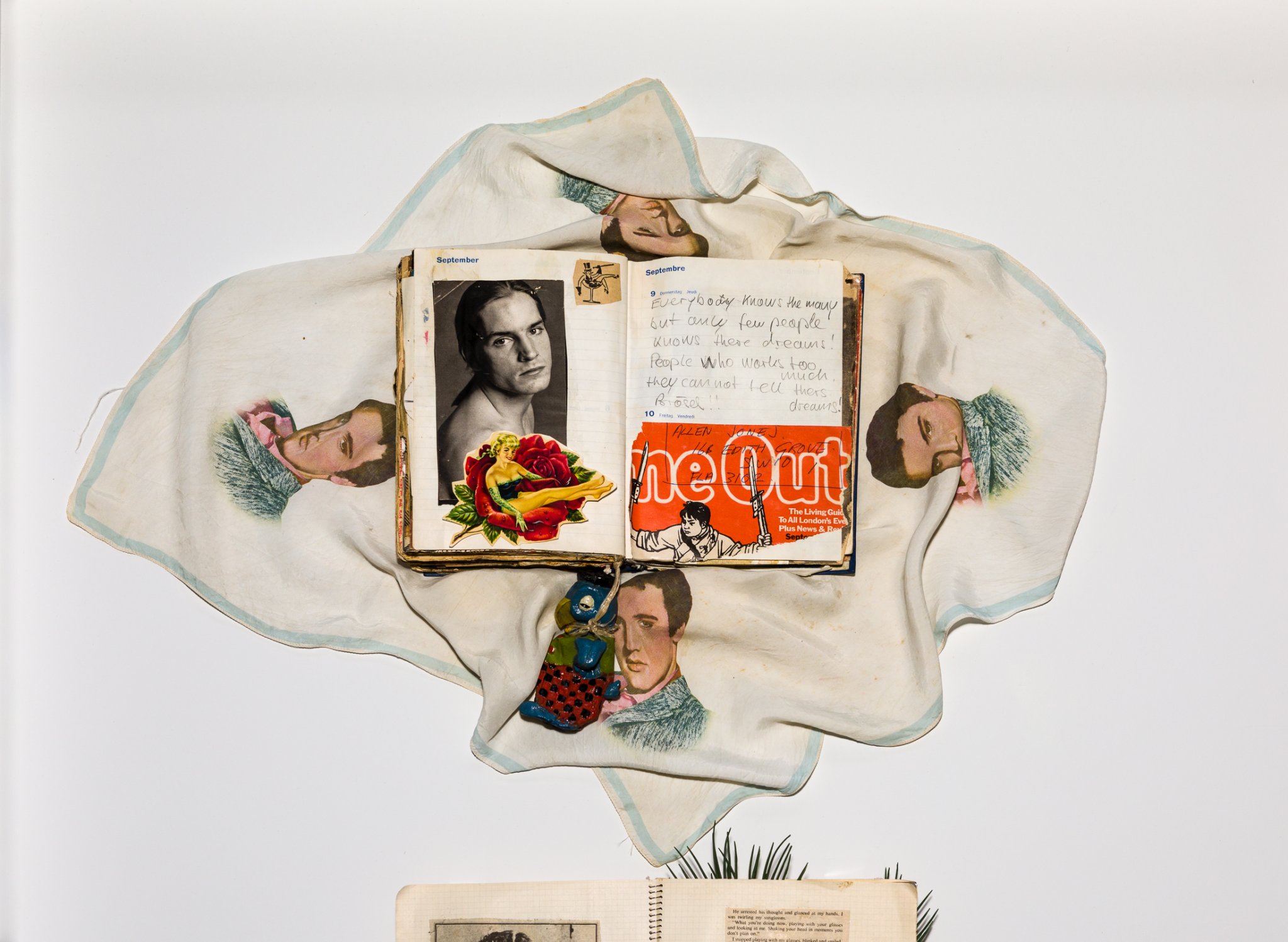
Untitled scrapbook, 1971.
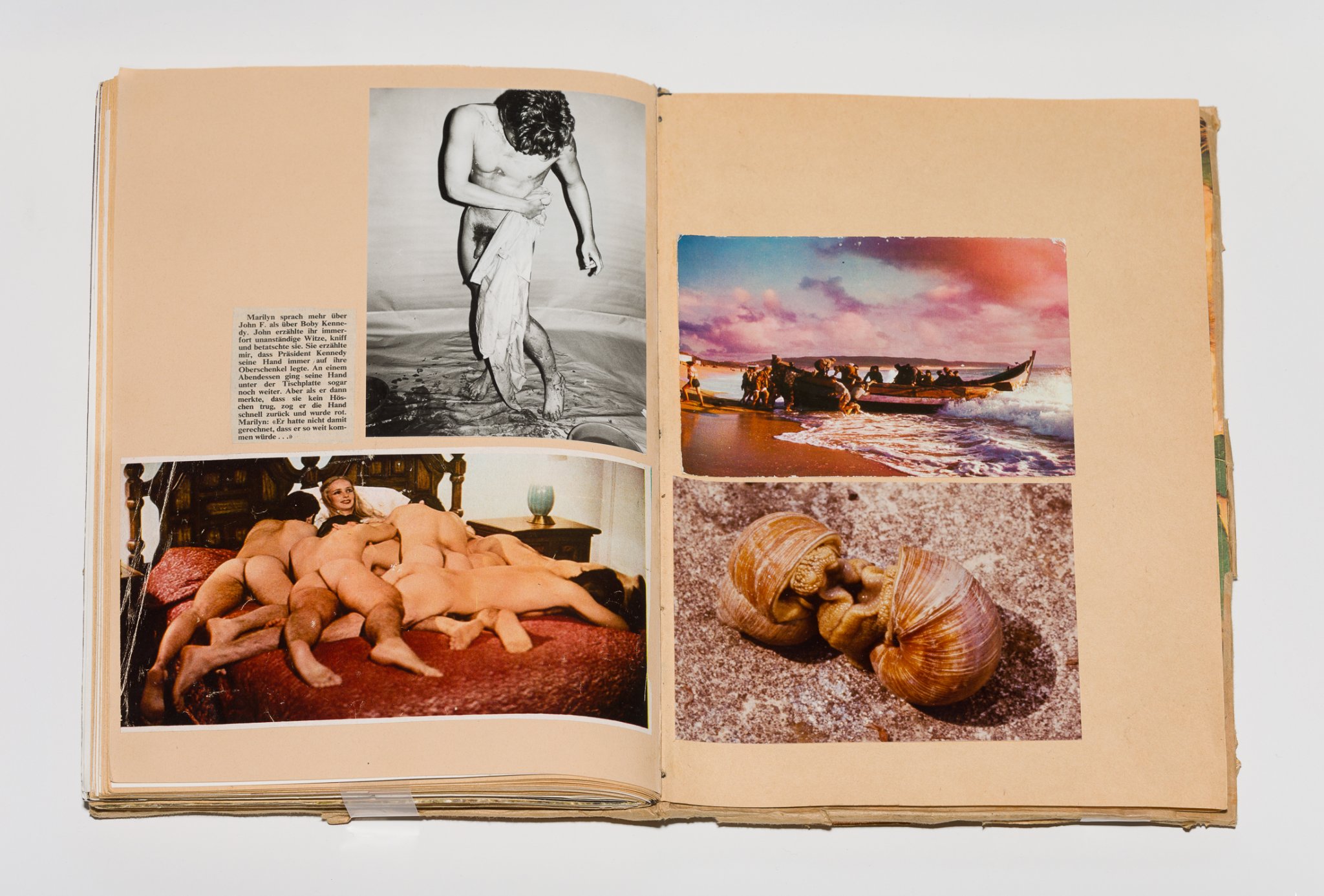
Untitled scrapbook, nd.
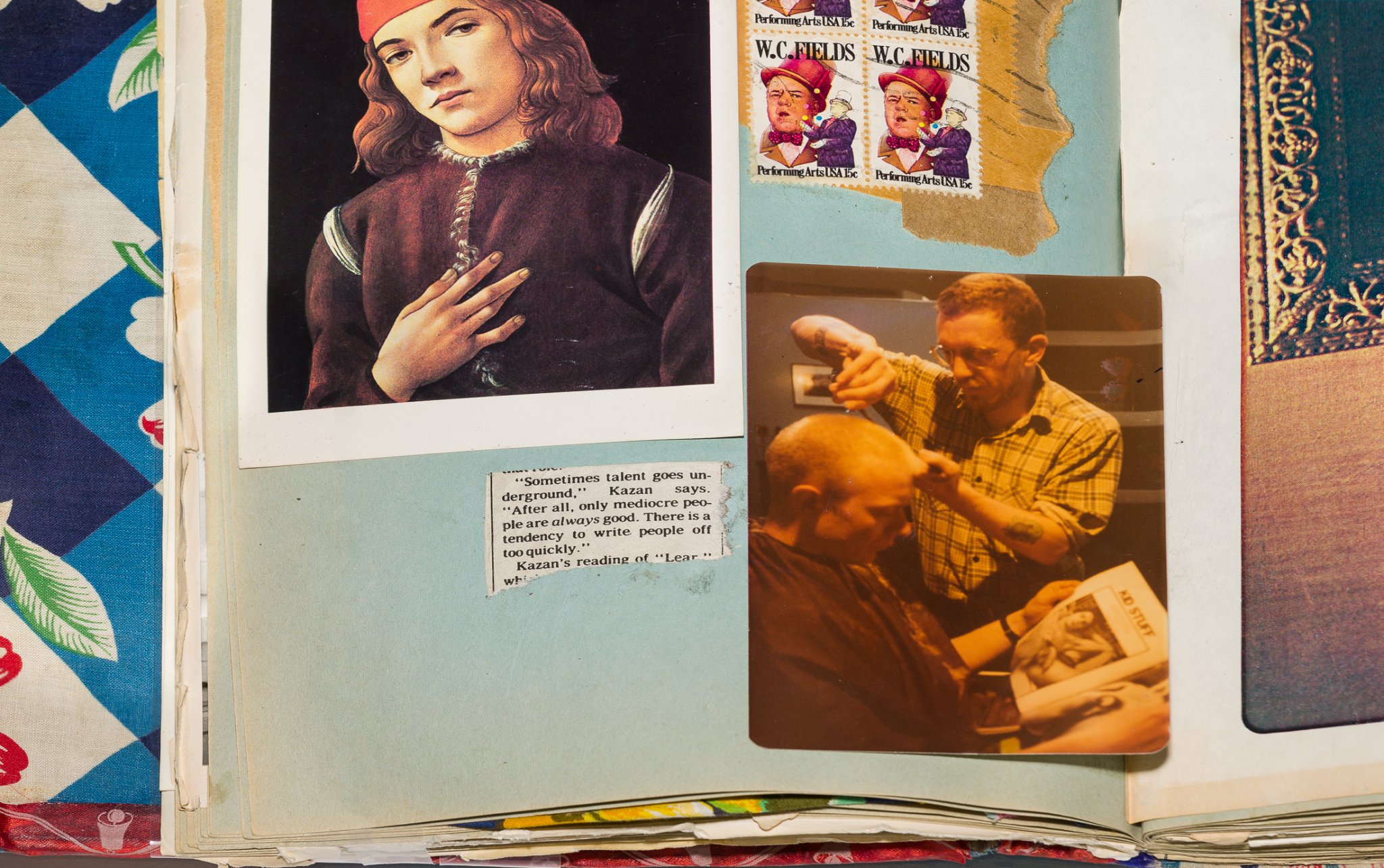
Untitled scrapbook, 1980.
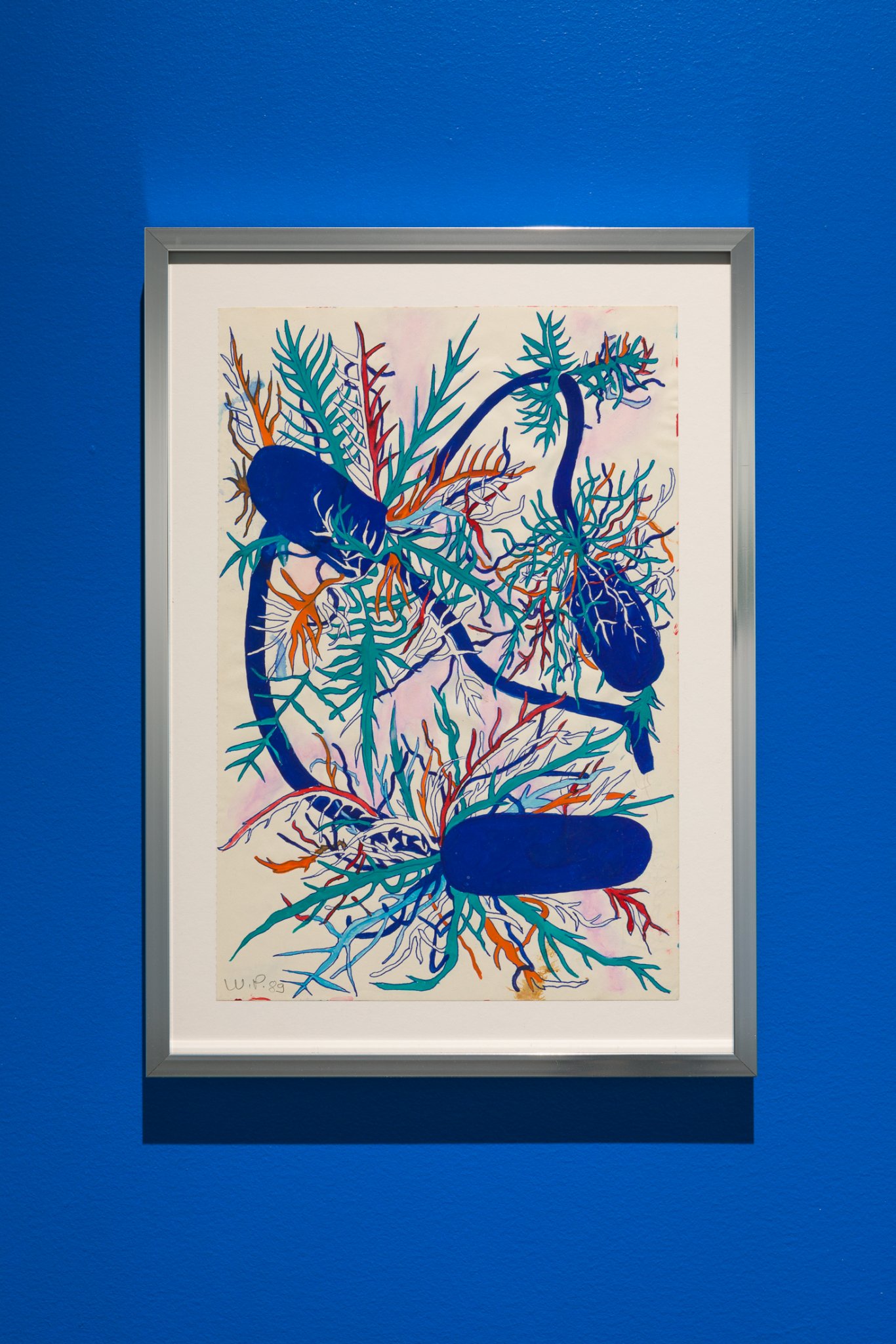
Untitled, 1989. Gouache on paper, 14 ¼ x 10 ¼ in. Collection of Beda Achermann.

Walter Pfeiffer, installation view.
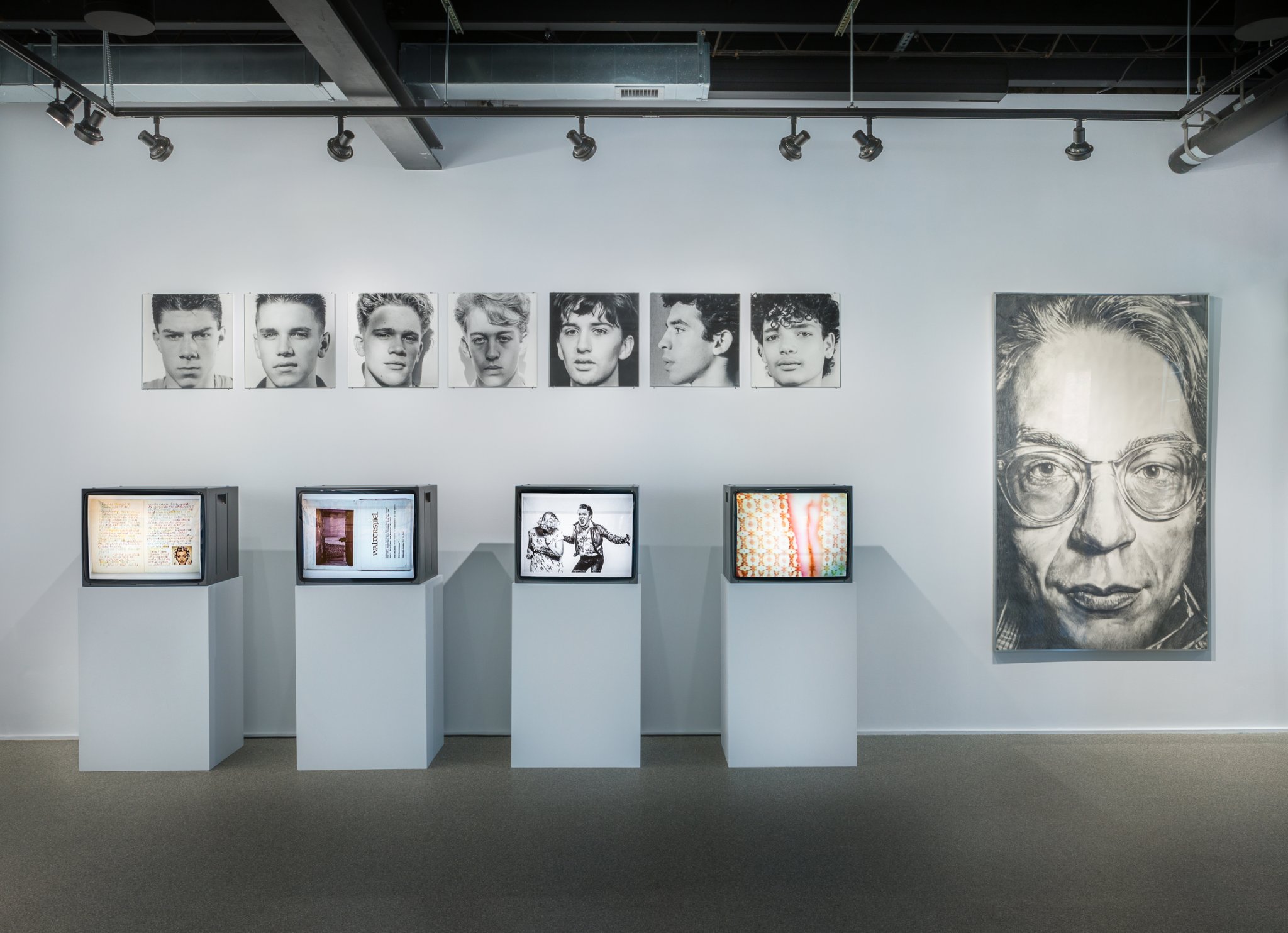
Walter Pfeiffer, installation view.
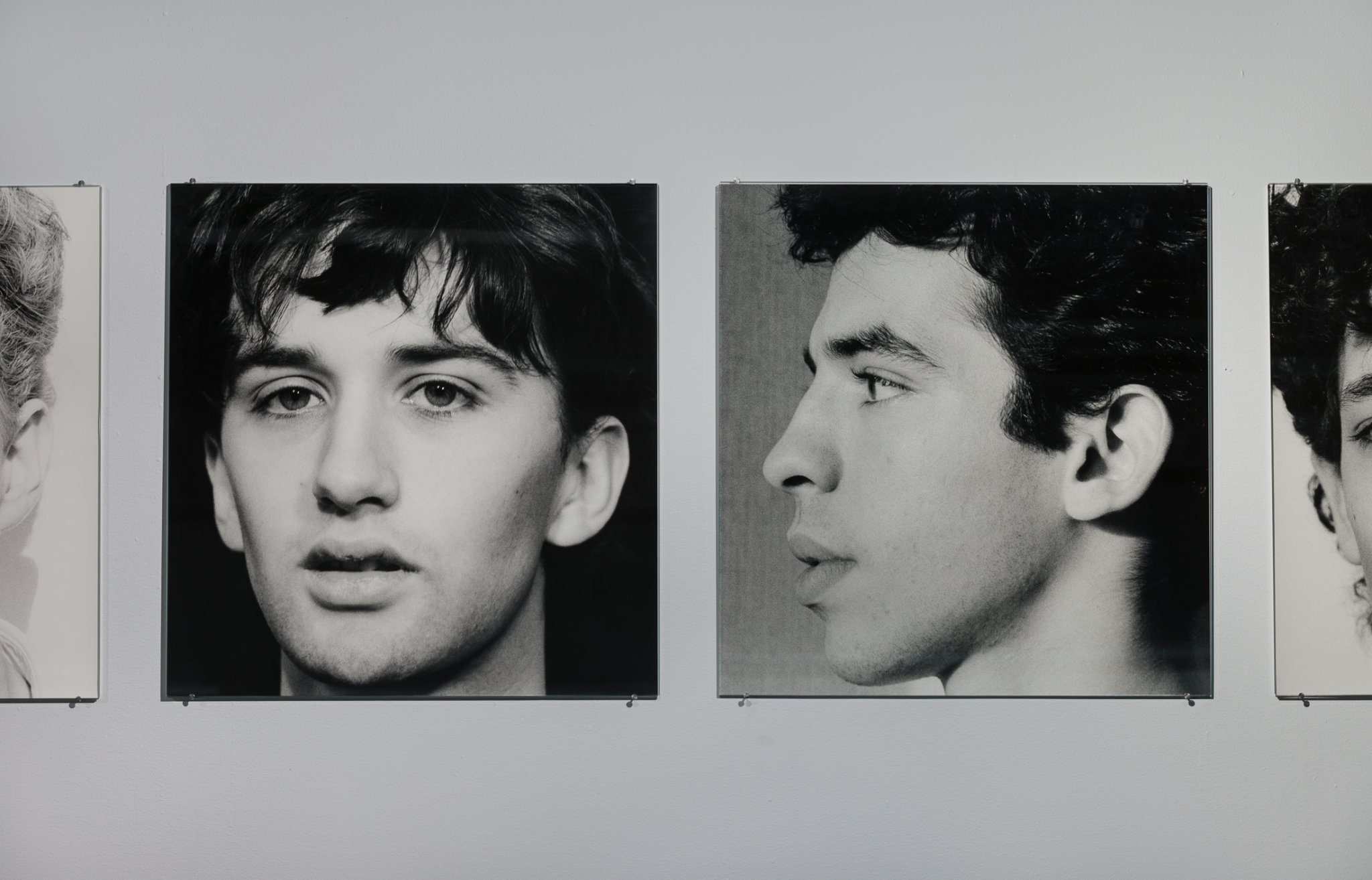
Selections from the series
Die Augen, die Gedanken, unentwegt wandernd, 1986. Gelatin silver print, 21 x 19 ½ in. Collection Fotomuseum Winterthur.
Photographed in Paris and Zürich, the series
Die Augen, die Gedanken, unentwegt wandernd (The eyes, the thoughts, ceaselessly wandering) frames the faces of young men in clinically uniform close-ups. Some models for the series were cast from chance encounters on the street, though several of Pfeiffer’s acquaintances appear as well. In an essay in the Summer 2003 issue of
Artforum, critic and curator Bob Nickas writes of the series: “As Pfeiffer gets
up close, he no longer occupies the space of a voyeur standing safely at a distance but an intimate space, where the person seen is there. Pfeiffer understands that scale relates
directly to the viewer, and it is to the viewer, not the subject, that the term lifesize can be applied...Evidence for Pfeiffer, no matter how direct, is never delivered dispassionately, and seduction is rarely achieved from a distance.”





































